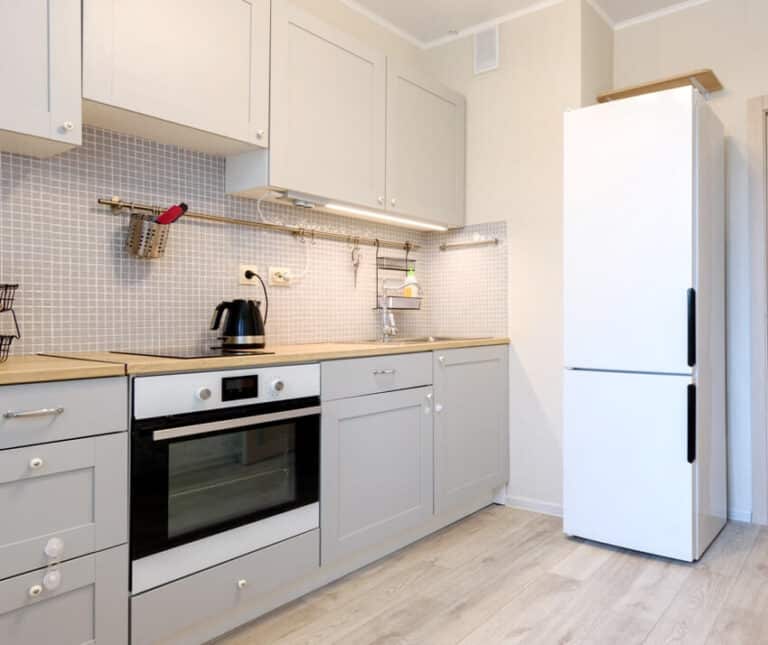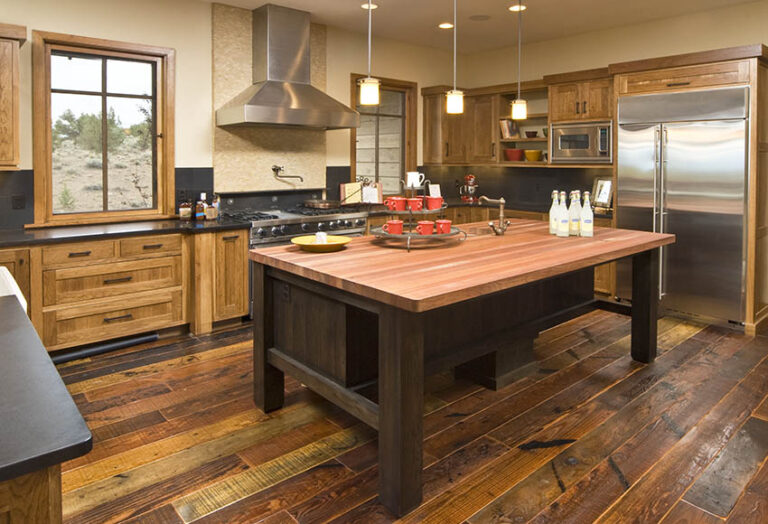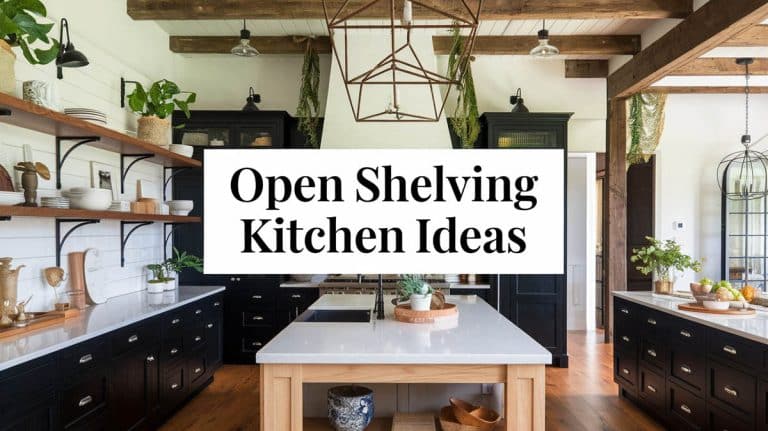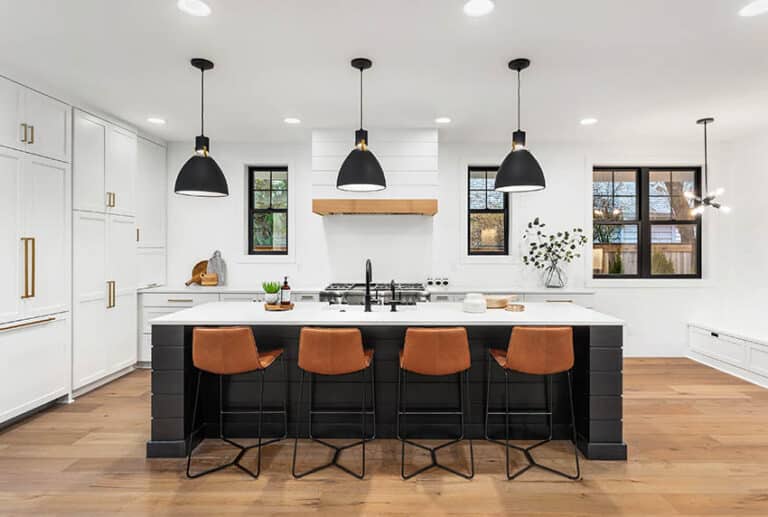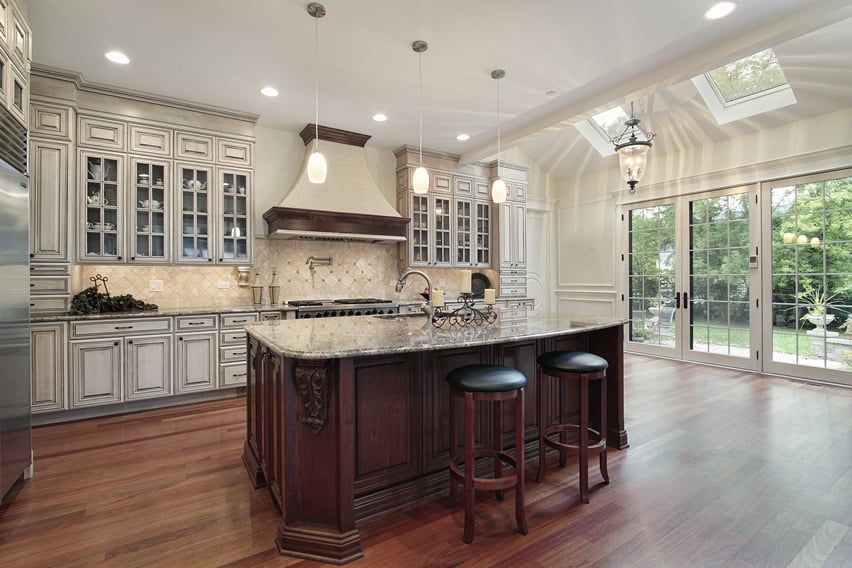Interior Designer Tips For Choosing Kitchen Cabinet Styles
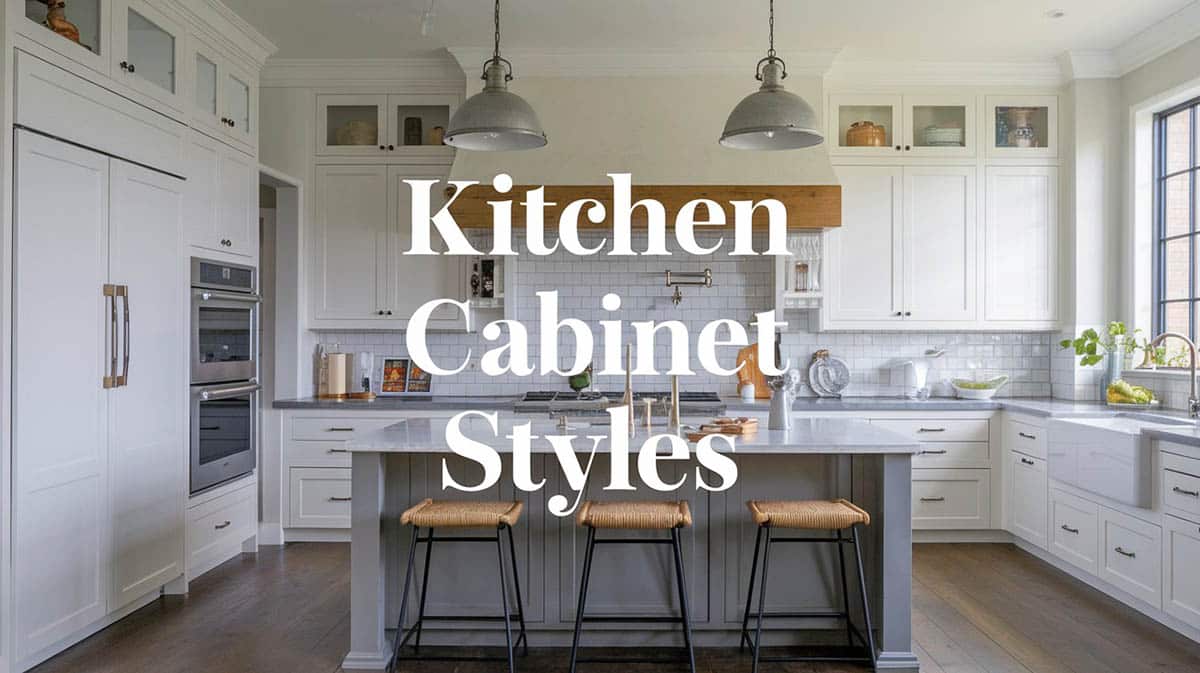
There is no doubt that the most dominant feature in a kitchen is the cabinets. It comprises more than 50 percent of the design and is the first thing that you see the moment you walk into a kitchen. They serve as strong focal points in a space while serving functional benefits in terms of storage and organization. The choice of kitchen cabinets will greatly define the overall look and style of your kitchen while also giving it a unique character.
The cabinets you choose for your home improve visual aesthetics, set the mood, and add decor to a kitchen space. The cabinet will also affect the layout of the space, accessibility, convenience, efficiency of workflow, storage capacity, and lifespan of the kitchen. As we can see, the majority of the factors that constitute the functionality of the kitchen are highly dependent on kitchen cabinets.
With these, it is important to take time to know all possible options for kitchen cabinetry design, style, and material. The market provides us with so many options for cabinetry, and choosing the right one to fit your home can get quite confusing. But with a little “know-how” on kitchen cabinet basics, you can easily create a stunning kitchen design that is truly one of a kind. Join us as we explore everything and anything you need to know about choosing and designing the right kitchen cabinetry for your home.
Kitchen Cabinet Styles
Kitchen cabinets take on different looks, and each type of cabinet door design corresponds to a specific design style. Here are some of the most common kitchen cabinet styles:
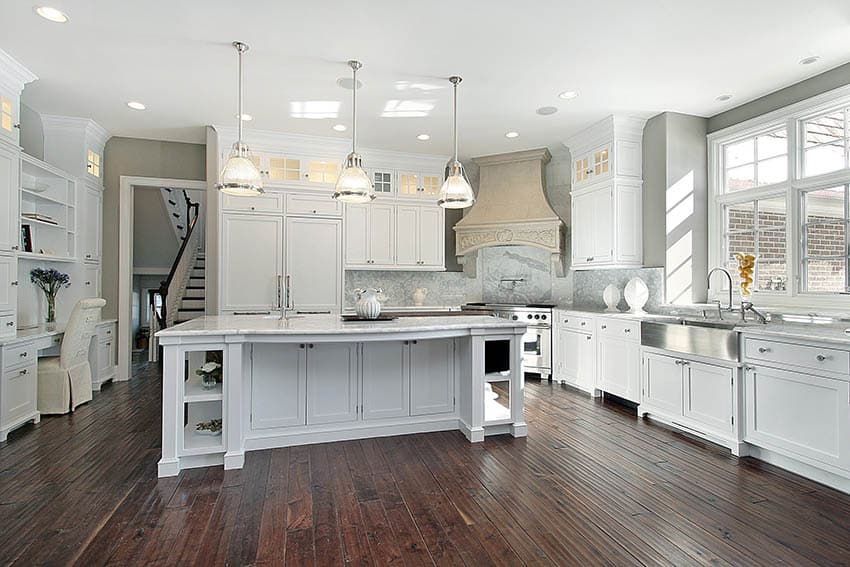
Shaker Style Cabinets
The Shaker style cabinet design originated during the American colonial era and was characterized by its simplicity and functional aesthetic. This design veers away from ornamentation and has a utilitarian design. Shaker style cabinets are known for their sturdy build, the use of quality wood materials, and a design made up of a paneled door with rail frames.
Considered one of the most popular cabinet design styles, a shaker cabinet door design is composed of a five-piece door with a recessed panel. Shaker style cabinets are very simple and clean, which makes them highly suitable not only for traditional-inspired kitchens but for modern and contemporary kitchen settings.
Materials used for Shaker style cabinets are quality types of woods like maple, cherry, quartersawn oak, and hickory. In terms of the finishes, Shaker style cabinets are typically left raw and in their natural wood finish. However, the finishing of Shaker style cabinets can be modified according to the prevailing style of the home.
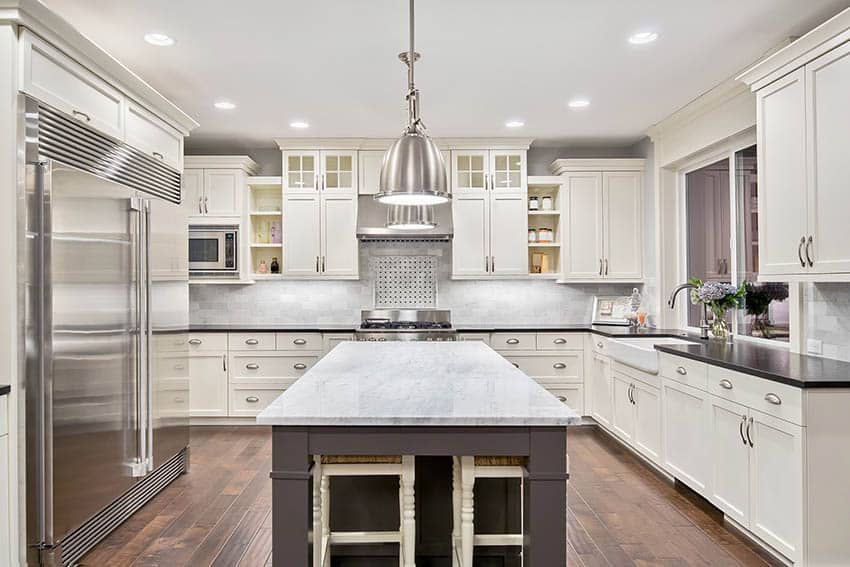
Painting Shaker style cabinets in white or gray, for example, allows them to fit in a more contemporary setting. Pairing it with a luxurious natural stone countertop and a rich color makes it well-suited for classic kitchen settings. Alternatively, using wood stains in deep, dark colors helps enhance the rich undertones and bring out distinctive graining patterns of the wood. Overall, Shaker style design offers flexibility and versatility in terms of design despite its traditional origins.
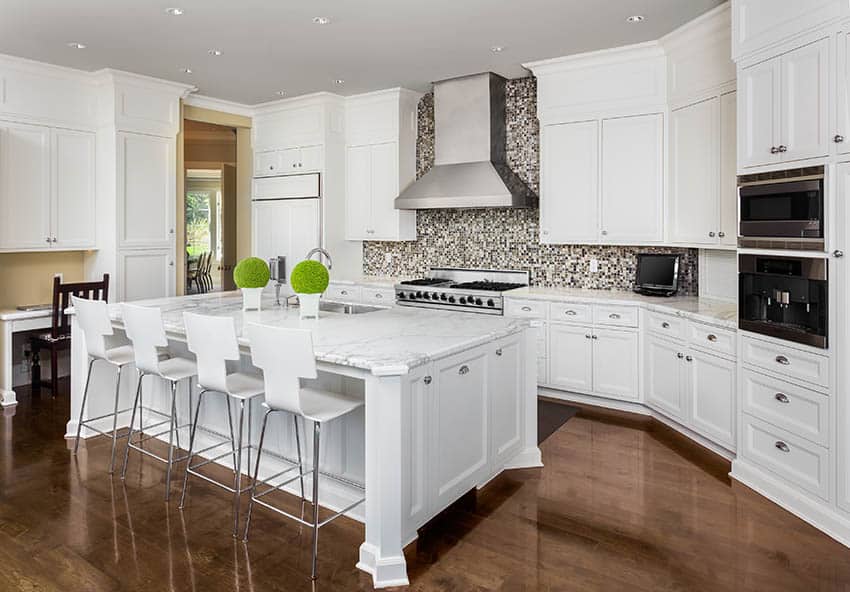
High-quality American wood is the primary material used for Shaker style kitchen cabinets. Examples of these are cherry, hickory, quarter-sawn oak, and cherry. All of which are notable for their resilience and durability. These cabinets are often left in their natural finish but can also be painted or stained. Staining is used to enhance the richness of the wood, while paints are used to create a lighter and airier feel. White, beige, and gray paint are some of the best options if you want to create a more updated look using Shaker style kitchen cabinets.
Shaker style kitchen cabinets are typically matched with light-colored countertops, while the decor, such as the appliance and cabinet hardware, varies depending on the look you want to achieve.
Flat Panel Cabinets

Flat panel kitchen cabinets are characterized by a clean, sleek, and unornamented design. This cabinet style is characterized by doors with flat center panels rather than being contoured or raised. Among all kitchen cabinet styles, the flat panel design has the most plain aesthetics that do not make use of any detail.
Flat panel kitchen cabinets usually come in a solid wood or a decorative laminate finish. Using solid wood for a flat panel kitchen cabinet design showcases the raw, natural beauty of wood without any need for additional decor or ornamentation. However, if the project is leaning towards a more budget friendly option, decorative wood laminates can be used in order to mimic the appearance of real wood. Laminated flat panel kitchen cabinets also offer a wide variety of colors, designs and patterns to choose from, allowing you to create the perfect kitchen cabinet design that matches your personal taste and preference in style.
Flat panel kitchen cabinets showcase true beauty in simplicity with their minimalist aesthetics and clean, defined lines. It is stylish and makes a great match for modern and contemporary kitchen styles. Although flat panel kitchen cabinets have a sleek, clean, and modern appeal, they are also highly suited for traditional and transitional kitchen styles.
Inset Cabinets
An inset kitchen cabinet style is characterized by a design in which the face doors fit inside the face frame openings. Typically, most kitchen cabinet styles use the “overlay” construction in which the doors and the headers are slightly larger than the openings in the frame. Thus, they appear to be slightly raised. As such, the door and the headers also seem to be constructed in an overlapping manner. But with the inset style, the construction method and design are entirely the opposite. The cabinet doors and headers are inside the opening, with only minimal spacing between the components, hence the term “inset.” Compared to other kitchen cabinet styles, the inset kitchen cabinet design gives a full view of the cabinet frame.
The inset kitchen cabinet style took its inspiration from the Victorian and Georgian periods when skilled craftsmen and artisans were extremely popular. As one can notice, this kitchen cabinet door design requires precise skills and a refined construction method to manufacture. Thus, they are often more expensive and often fall in the high-end range.
Design-wise, the inset kitchen cabinet style offers a clean, streamlined look that exudes simplicity and elegance, making it a perfect choice for a wide range of interior design inspirations. It is highly customizable and can be modified using edge details that will allow you to create a more personalized look for your home. Some manufacturers offer a type of beaded and non-beaded inserts that is fitted into the cabinet door itself, providing a subtle design detail that adds to the overall aesthetics of the kitchen without overpowering all the other elements in the space. Moldings and other decorative embellishments can also be added, depending on the look you want to achieve. It is well suited for traditional, transitional, and contemporary styles.
Cabinets with Raised Panel Design
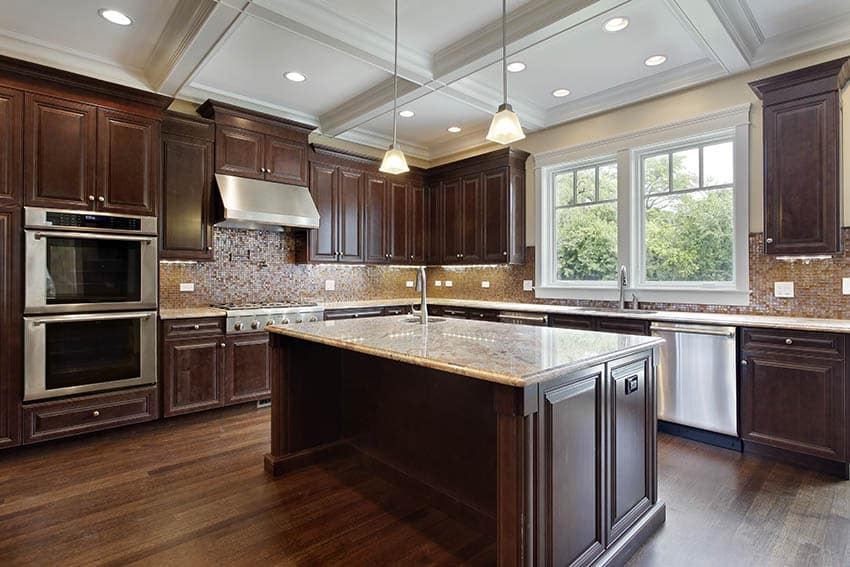
The raised panel kitchen cabinet style is characterized by a door design in which the center panel is raised above the rest of the cabinet door and ornamented with a surrounding recessed border, contour, or profile. Raised panel kitchen cabinets are more detailed compared to recessed panel cabinets.
This type of cabinet style is commonly used for traditional and transitional style kitchens. It is usually found in rustic and country-inspired homes and kitchens. Its appearance can be ornate or simple and can vary depending on which period style it gains inspiration from. One form of raised panel kitchen cabinet is the cathedral cabinet door or the raised arch design (which is also classified under the traditional cabinet style).
The application of the raised panel design is not limited to traditional designs alone, as it can also work for transitional settings. The main advantage that raised panel kitchen cabinets offer in terms of design is that they add dimension to a space.
Cabinets with Recessed Panels
Recessed panel kitchen cabinets are the opposite of raised panel kitchen cabinets. The primary difference between the two styles is the height of the center panel of the cabinet door face. The recessed panel kitchen cabinet style is characterized by a door design in which the flat center panel is recessed below the rest of the cabinet door and ornamented with a surrounding raised border, contour, or profile. Shaker cabinet design can be classified under the recessed panel kitchen cabinet style and is considered one of the most prominently used kitchen cabinet styles.
Compared to the raised kitchen cabinet style, the recessed cabinet design has a more sleek appearance, making it more suitable for modern and contemporary decor styles. The minimal presence of ornamentation conforms to minimalist design, and its simplicity allows it to blend well with contemporary-inspired interiors. Compared to raised panel kitchen cabinets, this style offers versatility and can work even in transitional and traditional kitchen settings.
Mullion Cabinets & Accent Styles
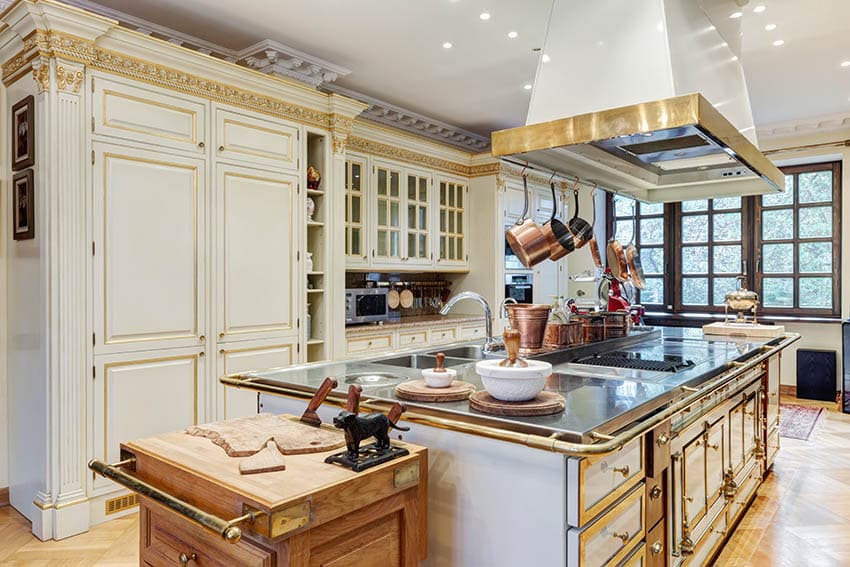
Accent doors are used in a kitchen to provide an added visual interest in spaces. This cabinet door design is typically used as accents or highlights to emphasize a specific area of the kitchen rather than being used for the whole kitchen space. Some accent cabinet doors make use of unique finishing materials, such as engravings on a wood panel or etchings on a glass panel. Typically, an accent cabinet door is installed as an overhead storage unit or above a row of cupboards, often used to display fine dinnerware and precious china. Examples of accent cabinet doors are glass insert doors, leaded glass cabinets, mullion-style cabinet doors, louver doors, stainless steel doors, and aluminum frame doors.
One popular type of accent cabinet door is the mullion style. A mullion-style kitchen cabinet door makes use of mullions or vertical and horizontal members, which separate glass panes or screens, acting as a decorative architectural element for doors and windows. Mullions may either be curved, straight, arched, or in a diamond pattern. Aside from functioning as a decorative embellishment, the vertical stiles in a mullion cabinet also act as a protection against glass breakage and as an additional door support. The mullion style cabinet door typically makes use of glass inserts, which are placed at the back of the cabinet door. It is also known as the “window style” because of its resemblance to a mullioned window. The mullion cabinet design is also a variation of the glass insert cabinet, but stiles are added to create a sort of a “French window” inspired design.
The mullion cabinet style is the perfect fit for traditional, classic, and transitional kitchens. It embodies timelessness and elegance while giving off a traditional feel to kitchens. However, it can also be used in more contemporary settings, as the design is highly customizable, too. Using textured accent windows paired with streamlined brushed metal hardware can easily update the look of traditional mullion cabinet doors.
Slab Cabinet Style
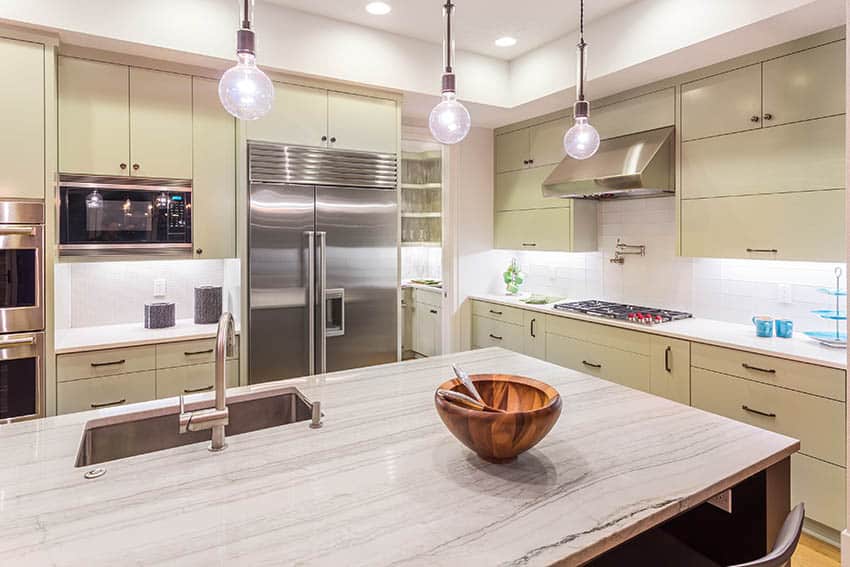
The slab kitchen cabinet style is the plainest and most simple cabinet door design because of its frameless appearance. Slab-style cabinet doors take after its name and are characterized by a single, unornamented piece of flat wood. It has no embellishments such as decorative molding or edgings and is ungrooved.
The slab style cabinet design is typically used for modern and contemporary kitchens because of its simple, streamlined, and minimalist look. It gives cabinet doors a smooth and sleek look. But despite its modern flair and elegance, it is the least popular cabinet design style. Slab-style cabinets are also more expensive compared to traditional designs such as the Shaker style cabinet.
Beadboard Cabinets
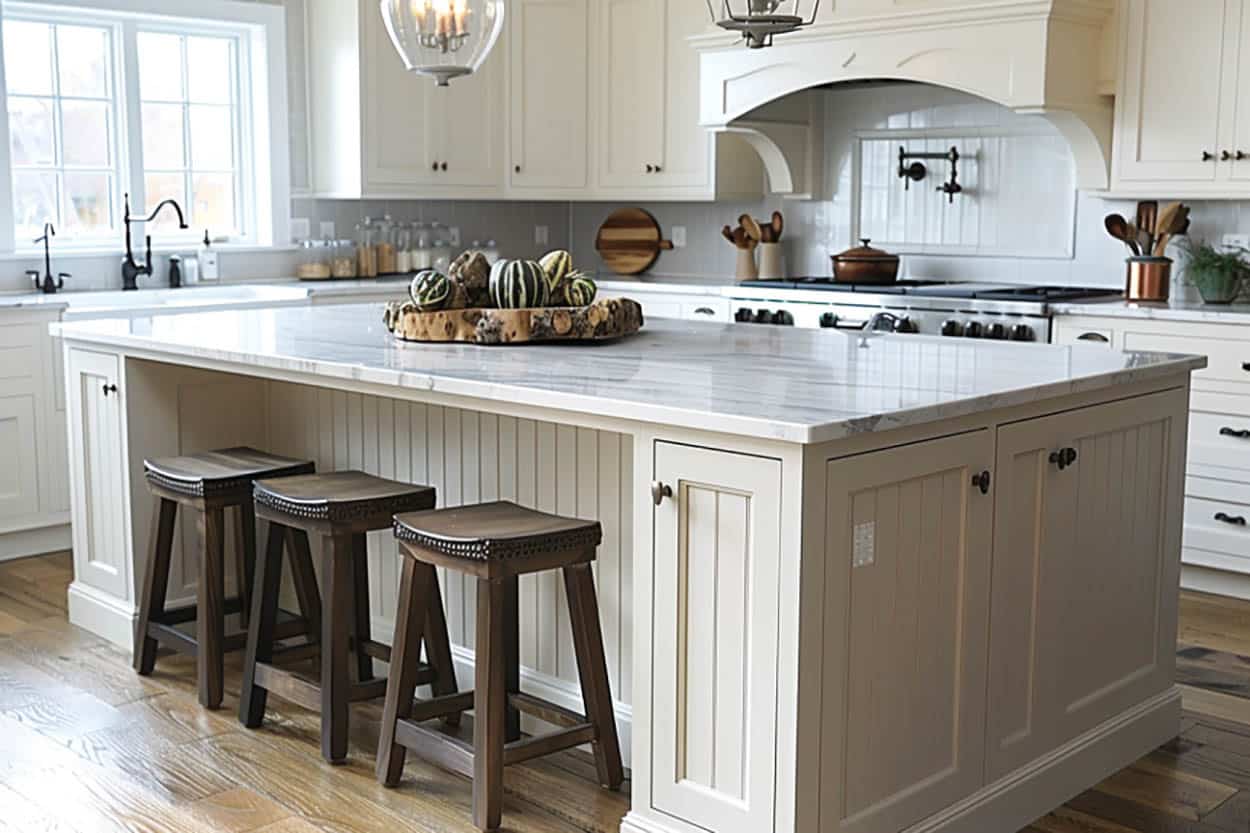
A beadboard is a row of narrow wood planks that are lined up vertically. Each wood plank has a little ridge in between or a joint where the planks meet which is called a bead. The type of construction that a beadboard panel has traditionally follows a tongue and groove connection in which the tongue of the plank is inserted into the groove of the next plank, perfectly joining the pieces of planks together to form a whole panel of vertical slats.
Beadboard panels are commonly used as a decorative treatment for walls during wainscotting in residential interiors and are traditionally used as a wall finish before plastering, paint, and drywall became famous. It can also be found in bathrooms, living rooms, and bedrooms.
The beadboard cabinet style makes use of a cabinet door design in which the center panel looks like a traditional beadboard panel. Typically, beadboard doors are painted in white or light colors to complement traditional spaces. Beadboard cabinets are often associated with country, farmhouse, or cottage-inspired kitchens. They contribute a rustic feel and cottage charm to kitchens, making them feel more homelike and cozy.
The chic appeal of beadboard kitchen cabinets makes them popular in the kitchen design scene. Frequently painted in white, beadboard style cabinetry produces a bright atmosphere for kitchens. However, one major drawback of using beadboard cabinets is the maintenance it requires. The grooves and slats in between the cabinet door can be hard to clean.
Louvered Cabinets
Louvered kitchen cabinet doors make use of horizontal wood slats that are evenly spaced between each other. Louvers are typically used in windows, interior doors, and furniture pieces, but adapting them into a kitchen cabinet door design adds a distinct amount of visual interest to the space.
Aside from the aesthetics that the louvers contribute to the cabinets, the spaces between the louvered doors provide adequate ventilation. This type of cabinet door style is not only used in kitchens but for several applications as well, which require ventilation, such as a clothes drying cabinet, a shoe or bag closet, cabinetry for home entertainment appliances like cable boxes or DVD players, or a concealment for an air conditioning unit.
Traditional Cabinets (Single Arch and Double Arch Design)

Traditional kitchen cabinet styles are often ornamented with as single arch on top of the cabinet face or door panel. The most popular type of traditional kitchen cabinet style is the “cathedral style” or the rounded cathedral top design. This is also the most commonly used kitchen cabinet design style for budget houses and rental apartments. Because of its very affordable price, it is also widely used for budget-friendly home remodel projects.
Another variation of the traditional cabinet style is the “double traditional kitchen cabinet style”. This design makes use of double-rounded arches, instead of one, found both on the top and bottom of the panel. The arch design is produced through the use of deep grooves, which produce a prominent shadow effect. When it comes to cost, the single-arch design and the double-arch design have the same price. This design can be achieved through the use of natural solid wood, thermofoil, or MDF.
Cabinets with Glass Inserts

The cabinet style with glass inserts makes use of a glass panel instead of a full solid wood cabinet door face. Also known as the glass framed door, this type of kitchen cabinet design can use either clear glass, smoked or frosted glass, colored glass, or textured glass. The most common type of glass panel used for this design is clear glass, which allows the users to see the contents of the cabinets without having to open the door. Alternatively, frosted glass can be used if you want to keep clutter out of sight while still providing variation in the finishes and breaking off the heaviness of solid wood cabinetry. Frosted glass is also more commonly used for more modern and contemporary designs.
The glass insert kitchen cabinet style not only provides an efficient way to locate utensils and tools in the kitchen but also provides homeowners a way to showcase and display their collections of tableware and dinnerware. In addition to that, this type of kitchen cabinet design also provides an open feel to kitchens, making them more airy and bright.
Thermofoil Cabinets
Thermofoil kitchen cabinets are a type of cabinet that is made up of MDF or medium-density fiberboard. The doors are molded out, wrapped with a plastic coating, and allowed to bake in high heat to create an impervious seal. Compared to regular painting, staining, and coating, this finish is more tedious, and instead of using solid wood, it makes use of a composite material.
The two materials that make up this type of kitchen cabinet are thermofoil and MDF. Thermofoil is a type of flexible, thin vinyl material that has no metal content. It acts as a layer of coating that is vacuum-pressed above the main cabinet material which is MDF. MDF, or medium density fiberboard, on the other hand, is made up of recycled wood fibers that are bound by resins. It is machine-dried and pressed into sheets to produce a stable and sturdy material which is better than solid wood.
MDF kitchen cabinets can stand up to heat better and adapt well to changes in humidity and exposure to moisture. MDF alone is not strong enough to be used as a cabinet material, but once treated with thermofoil, the result is a smooth cabinet door that resists chipping and damage better than regularly painted cabinets.
Thermofoil cabinets are often mass-produced and typically used in modular kitchen systems. They are a mainstay in budget kitchen remodels, condominiums, apartments, and workshops. It has high durability, but once it gets damaged, it can be hard to repair. Thermofoil kitchen cabinets are considered to be cheap and also offer versatility and flexibility in terms of design. It usually comes in wood-like finishes which show graining patterns or in solid colors.
Thermofoil kitchen cabinets are also easy to maintain. It can be cleaned easily by wiping and resists stains better compared to natural wood. Unlike solid wood cabinetry, which needs sealing, thermofoil cabinets do not require any special treatment for protection.
The major drawback of thermofoil cabinets is that they do not stand up to heat well. Their poor resistance to heat causes the laminate to pull away from the MDF panel. With that, installing them too close to a heat source may potentially cause a problem later on, but this issue can be rectified by installing a heat shield for the cabinets. Another problem that thermofoil cabinets pose is that the light color variants tend to have some discoloration and may turn yellowish over time. However, the positive features of thermofoil cabinets still outweigh the negative ones, which makes them a cost-effective kitchen cabinet option.
Custom Cabinet Doors
If you can’t find any kitchen cabinet design style that does not fit your taste, you can always look for custom design cabinet manufacturers that can help you turn your designs into reality. Craftsmen and millwork manufacturers can customize any style or look you want and can create specialty moldings, carvings, and decorative details based on your preference.
Custom kitchen cabinet doors are those that are “made to order” according to the specific requirements and preferences of the client. However, this option is considered to be expensive because of the labor, time, and effort that goes into it. We cover custom kitchen cabinets in further detail, including types of hardware, finishes, and door types below.
Cabinet Door Finishes
Finishes are the final step added to kitchen cabinetry after it undergoes construction. The purpose of finishing materials is to add color, enhance aesthetics, and at the same time, provide added protection to kitchen cabinets. There are several options to choose from when deciding on the right finish for your cabinet, and each has its own positive and negative features. Here are some types of kitchen cabinet door finishes :
Stain – Staining is a type of cabinet finish that makes use of varnish, lacquer, polyurethane or shellac that enhances the natural color of wood. By definition, wood stains are composed of colorants that are suspended in a vehicle, such as alcohol or a finishing agent like varnish, lacquer, shellac, or polyurethane. These colorants are not fully dissolved in the vehicle.
Staining brings out the natural graining pattern of the wood. The knots and grains of wood absorb the stain, leaving them with a darker color and a more highlighted appearance. It gives off a handcrafted look to kitchen cabinets while allowing their natural beauty to stand out. Wood stain can be easily applied to kitchen cabinets by hand rubbing or using a cloth.
One important thing to consider when using wood stains is the species of wood that you are using. Some woods tend to absorb wood stains better, while others soak in fewer stains. Overall, this finish creates emphasis and a highlighting effect on wooden cabinetry.
Painted – Paints are not only commonly used for interior and exterior walls and ceilings but also for kitchen cabinetry. It is also one of the easiest and quickest fixes to finish and update the look of cabinets. A fresh coat of paint for kitchen cabinets can instantly transform your kitchen’s overall look and character.
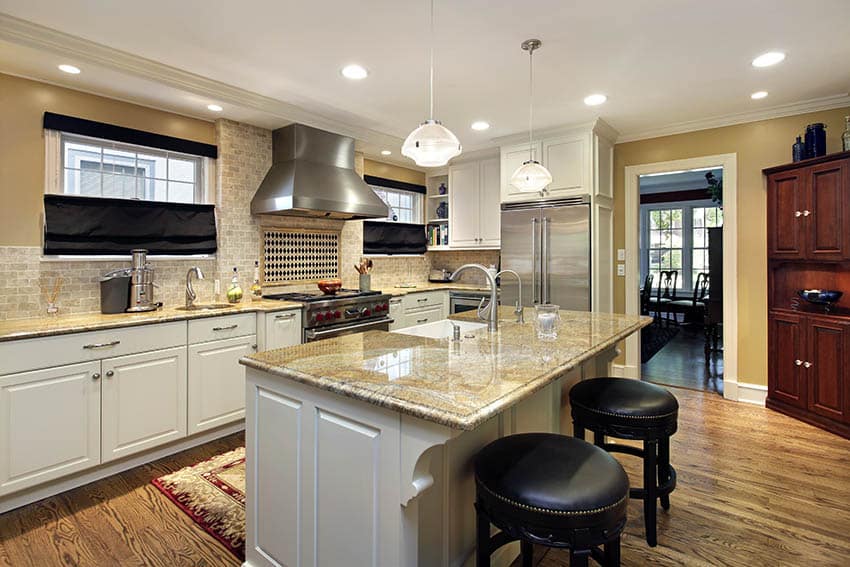
Paint is available in a limitless number of shades, allowing homeowners to customize their own kitchen cabinetry in any color that suits their personal preferences and style. Aside from that, there are several paint finishes that one can choose from. One popular example of such is the Duco paint finish, which gives wooden kitchen cabinets an opaque finish that hides their natural grains. This type of paint finish can also be used to achieve a high gloss, semi-gloss, satin, or flat finish. It gives kitchen cabinetry a smooth surface and an expensive and luxurious look.
The types of paint used for wooden kitchen cabinetry are acrylic enamel paint, water-based paints, or alkyd paints. Acrylic or water-based paints are a type of paint that can easily be cleaned off with water. They contain less fumes and are often odorless. Alkyd paints, on the other hand, are oil-based and typically have a strong odor. Instead of using water for cleanup, alkyd paints use mineral spirits.
Paint is readily available at an affordable cost in most home improvement stores. In addition to that, paint can be easily applied and may be undertaken as a DIY project. Painting kitchen cabinets can either be done by hand application using a paintbrush or roller brush. Alternatively, it can also be applied by spraying using a paint compressor.
Varnish – Varnishes are often applied as a topcoat for painted or stained kitchen cabinets. This finish provides durability and resistance to heat and keeps cabinets from corroding. Varnishes are traditionally made up of a combination of resin and oils. As it dries, the result is a hard surface and a fade-resistant finish on cabinets. Varnishes also come in a variety of colors. Tinted varnishes have rich colors, which can be used to show off the graining pattern of wood more. Aside from traditional and tinted varnishes, other types of this finish include catalyzed varnish, which is a fast-acting varnish that is more durable and corrosion resistant, and polyurethane varnish, which is thicker and creates a glossy appearance for kitchen cabinets. One major drawback of this type of kitchen cabinet finish is that it has the tendency to chip and wear over time.
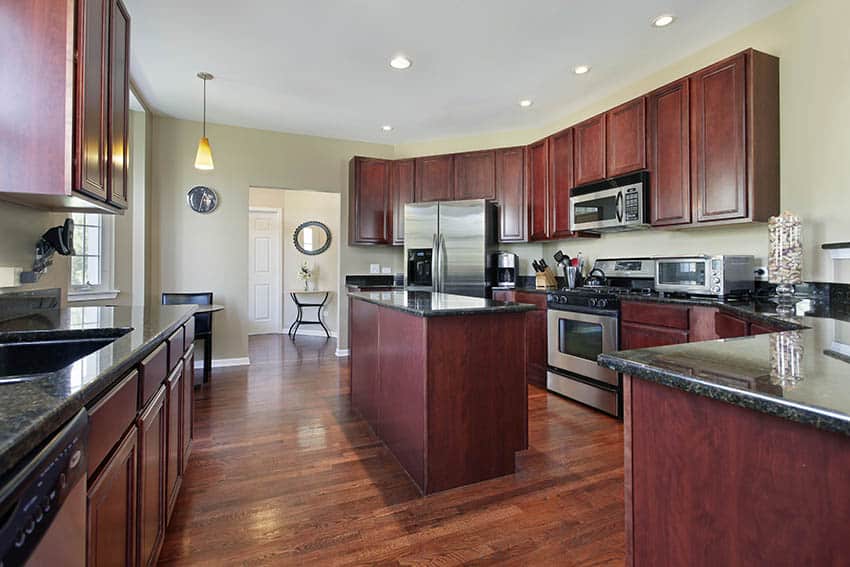
Acrylic – Acrylic finish is a type of nontoxic finish that is mainly composed of acrylic acid. It gives kitchen cabinets a high gloss finish that is ultra smooth and has a sleek, mirror-like appearance. Acrylic is available in a wide range of colors which can suit a variety of kitchen palettes. This type of finish is also known to last for years without fading or discoloration. Acrylic kitchen cabinets are commonly used for ultra-modern and minimalist kitchen interiors.
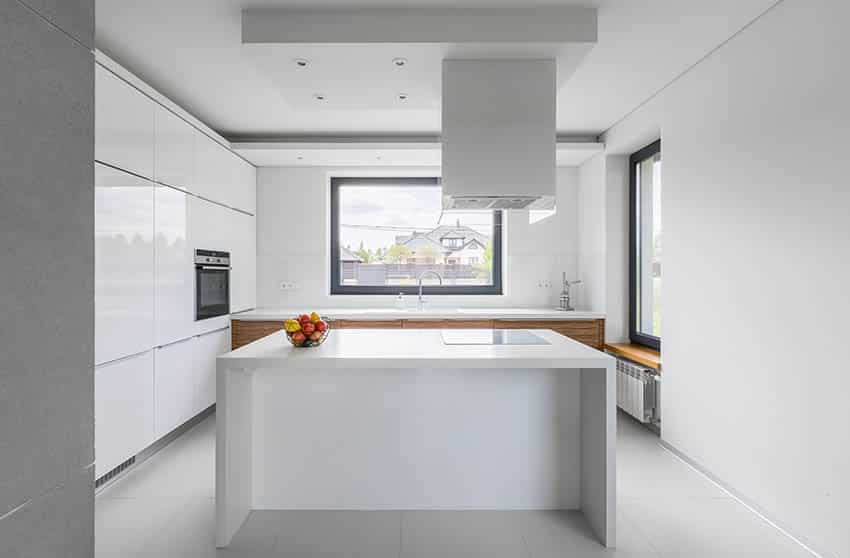
There are two types of acrylic finish for kitchen cabinets, namely solid acrylic doors and acrylic faced doors. Solid acrylic doors have a richer appearance because their full body is finished with acrylic. Their colors are more even, but they have a higher price. Acrylic-faced doors, on the other hand, are just coated with several layers of acrylic. The manufacturing process involves applying sheets of acrylic over an MDF panel. These boards are then sealed at the edges and applied with a protective coating.
Some advantages of acrylic finish cabinets include high durability, the ability to withstand wear and tear from everyday use, and resistance to scratches. In addition to that, acrylic finish kitchen cabinet doors are easy to clean. However, there are still a few drawbacks to this type of cabinet finish. Since acrylic finishes have a glossy look, fingerprints and dirt are more visible on the cabinet’s surface, thus requiring frequent wiping and regular cleaning. In addition to that, an acrylic finish is also more expensive compared to other kitchen cabinet finishes.
Glazed – Glazing is a type of finishing for kitchen cabinet doors that makes use of a “glaze” or a transparent or semi-transparent coating that is applied on top of a cabinet that has been painted or stained. The purpose of glazing is to add color or to provide a glossy shine to kitchen cabinets. Glazing also highlights design details in a kitchen cabinet door, such as decorative embellishments, moldings, corners, and other carvings. It is considered a premium type of kitchen cabinet finish.
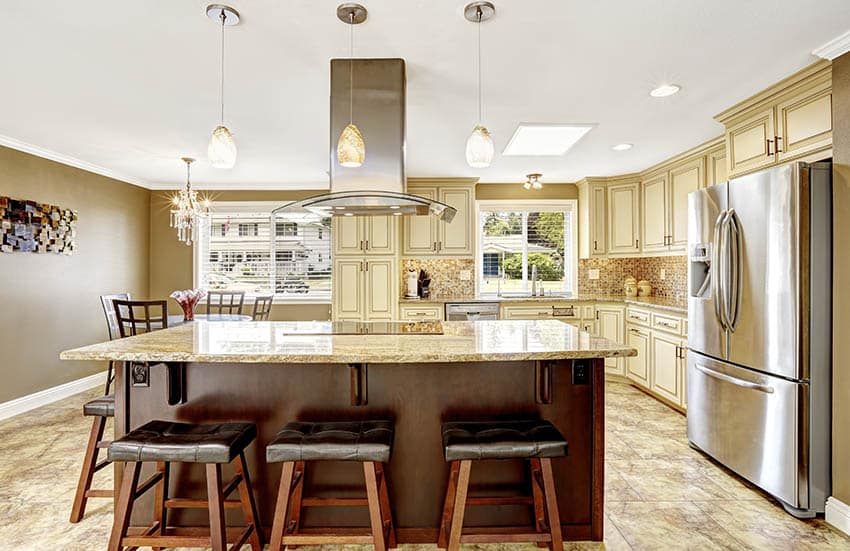
Glazed kitchen cabinets come in two forms. First is a pre-glazed kitchen door, which is already ready-made and finished, while the other one would still include self-application of a store-bought glaze. The glazing process involves painting or staining the cabinet first and then allowing it to set for some time. Once the paint or stain has dried, a thin coat of glaze is applied over the cabinet door using a brush, and then the excess is wiped. The glaze is then allowed to cure, and once fully dried, a top coat of polyurethane is added.
Glaze usually comes in a variety of colors like bronze, mocha, cream, white, coffee, etc. There are two popular glazing finishes used for kitchen cabinets, namely, white glaze and dark glaze. White glaze is typically applied on white-painted cabinets, while dark glaze is usually used for stained cabinets. Others combine both in order to produce a more antique look.
Glaze kitchen cabinets give off an antique look and a rustic, Old World feel to kitchens. It is highly suited for country or rustic-inspired kitchen settings. Glazed finish is highly suitable for cabinets which have intricate carvings and details. The typical cost of glazing for kitchen cabinets is $8 to $10 per square foot.
Weathered Finish – The weathered finish, also known as the distressed or antiqued finish, is a type of faux finish that is added to kitchen cabinets to give them a worn-out look or an old appearance. Pre-distressed or ready-made weathered kitchen cabinets may be purchased from some suppliers. However, this finish can also be achieved through a ‘do it yourself project “ using simple materials and a ready-made antiquing glaze. The process involves a lot of sanding to get that weathered look and worn-out texture. You can read more about distressed kitchen cabinets here to achieve a weathered finish or see pictures of distressed white kitchen cabinets here.
Weathered kitchen cabinets give off an antique feel and a laid-back vibe. This finish is commonly used for traditional inspired kitchens such as country, old world, and rustic style. White distressed kitchen cabinets are also a staple for charming Cottage style kitchens.
Patina & Heirloom – Patina and heirloom finish is another type of vintage finish that gives kitchen cabinets an antique look. These finishes make use of handcrafted details and an artistic technique to produce a timeworn character. Patina and heirloom finishes are also well-suited for traditional kitchens.
The heirloom finish creates an antique appearance using stains, glazing, and distressing. Before the finish is applied, the kitchen cabinets are subjected to a distressing technique to give them a timeworn look. Sanding, denting, and chiseling the edges and corners give the wooden cabinets imperfections. Glaze is then applied to accentuate the details of the door. To create a more rustic and aged appearance, more imperfections may be added.
The patina finish is also a combination of different techniques, which involves over-sanding, distressing, and glazing. The cabinets are also subjected to heavy distressing using a chisel to produce marks, joint cracks, bird pecks, and dry brush, and then a coating of glaze is applied to accentuate the details of the door. The result is an aged appearance that is one of a kind.
Laminated Finish – Laminates are an extremely popular finishing material for kitchen cabinets. It is a type of synthetic material that is composed of several layers that are sandwiched together. Laminates are manufactured in thin sheets but are extremely durable and resilient because of their unique material composition. Laminates have three resin-reinforced layers. The top layer of laminates is made up of a protective layer of melamine resin. The second layer is known as the decorative layer since it contains the pattern, design, texture, and color of the laminate. The third layer, also known as the core layer, is made up of kraft paper that is reinforced with resins. The fourth layer, also referred to as the wear layer, is mainly composed of aluminum oxides, melamine resins, and paper.
Laminates are typically applied on top of a durable material or a wooden substrate in order to improve their appearance and quality. Heat, adhesives, and pressure are typically used to adhere laminates to the substrate. Some common base materials for laminated cabinet doors are strong plywood or marine plywood.
Laminates also come in two types: high-pressure laminates and low-pressure laminates. High-pressure laminates are more durable and resistant to damage. Their strength is comparable to a sturdy countertop. Low-pressure laminates, on the other hand, are less durable and have the tendency to chip or crack easily. It comes in a smaller variety of colors compared to high-pressure laminates. Low-pressure laminates are also made up of melamine. When choosing the right laminate finish for your kitchen cabinet, make sure to go with high-pressure laminates, as they tend to last longer. The most popular brand of high-pressure laminates is Formica.
Aside from the aesthetics that laminates contribute to kitchen cabinets, they give a number of other benefits. It is one of the most cost-effective choices for cabinet finishing materials. It does not warp, resists fading, and can stand up to heavy use. And since it is applied in sheets, the colors of your cabinets are more likely to be uniform and even compared to other finishes, which require application or brush coating.
The wide variety of colors, patterns, and textures that laminates offer make design possibilities endless, allowing homeowners to use them in any kitchen design style. The most common variant of laminates is the wood finish, which mimics the appearance of real, natural wood.
Unfinished Wood Kitchen Cabinets – Wood in itself is naturally beautiful, but rather than giving it a new finish, others opt for a more raw and organic look. Unfinished kitchen cabinet doors render natural coziness and a warm, inviting ambiance to spaces. It suits traditional kitchen settings like farmhouse, country, and rustic styles.
Some popular varieties of wood that look great with an unfinished look are cherry, maple, oak, hickory, and pine. Exotic woods like ebony, mahogany, and bamboo also have distinct appealing colors and graining patterns, which can lend a unique visual interest to kitchens. Cherry is a type of wood that is popularly used for the unfinished look because of its natural reddish to deep brown undertones. You can learn more about the natural colors of these woods as we go on with this article. Unfinished kitchen cabinet doors are very economical and cost around $5 to $50 a piece. It can be bought ready-made in home improvement stores.
Custom finish – Aside from the wide array of finishing options which are mentioned above, kitchen cabinets may also be custom finished. Custom finishes are typically hand-applied with a roller brush and then given a top coat. Custom cabinet finishes allow homeowners to create a design that perfectly matches their own preferences in style. Some manufacturers can even match your favorite paint color to create a cabinet finish that is truly one of a kind. Custom finishes and colors for kitchen cabinets are typically mixed by manufacturers and sent to the homeowner for approval, allowing for endless options in mixing and matching when it comes to kitchen design.
Wood Cabinets Styles (Types of Wood)
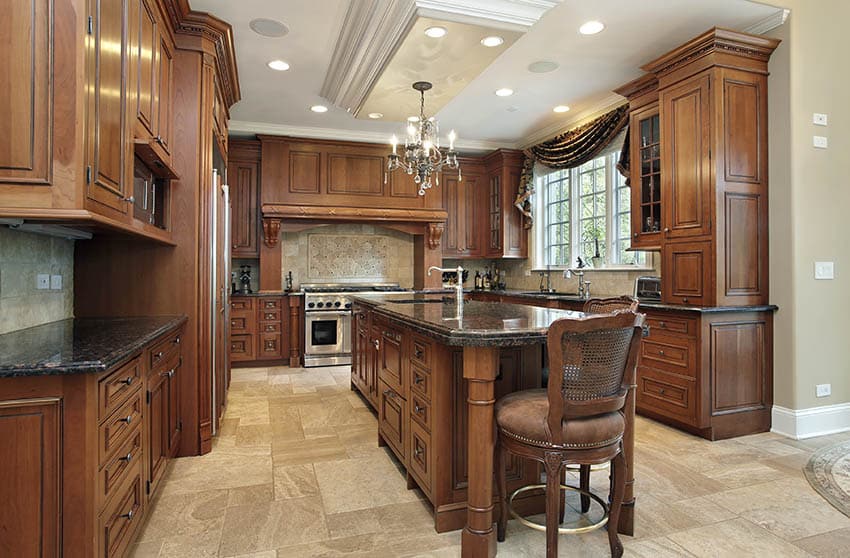
Kitchen cabinets are traditionally made up of hardwood. The distinct beauty of wood and the natural coziness and appeal that it contributes to spaces make it well-loved by most homeowners and designers alike. Aside from the stunning visual aesthetics that wood cabinetry contributes to kitchens, some of its notable characteristics include durability, high customizability, versatility, and flexibility.
In order to save on costs, some alternatives were developed. Cabinet materials like veneers and laminates are produced to mimic the appearance of wood, and alternatively, these materials are applied to a substrate like plywood, MDF, or particle board. However, some people still prefer the real thing and go for solid wood kitchen cabinetry.
Wood has a lot of species, and not all kinds are suited for use as kitchen cabinetry. Since kitchens are constantly subjected to everyday use and moisture, the materials for kitchen cabinetry need to be resilient and tough. Wood has the natural tendency to warp, rot, and decay over time, and in order to prevent such, it is subjected to treatment before use. In order to create a long-lasting kitchen cabinetry design for your home, it is important to know a few basics regarding different types of wood that can be used for this application.
Here are some types of wood that are commonly used for kitchen cabinetry:
Cherry – Cherry is one of the most popular species of wood and probably the best type of wood for kitchen cabinets, particularly for traditional settings. Its distinct natural deep reddish brown color and fine graining pattern offer richness and luxury to kitchens. Another distinct characteristic of cherry wood is that it ages gracefully as its colors change into different tones over time, offering different looks throughout its lifespan.
Aside from its stunning beauty, cherry is also highly durable and can withstand scratches and knocks. Although more commonly found in traditional kitchens like Craftsman style or country kitchens, cherry wood kitchen cabinets may be used even in contemporary settings using the proper cabinet design and millwork. (Visit our cherry wood kitchen cabinets gallery for more designs.)
Maple – Maple is a light-colored wood that has a subtle fine-graining pattern. It is predominantly white in color but has variations that range from a creamy white tone to occasional reddish-brown undertones. Generally, maple wood kitchen cabinets have a smooth, uniform appearance. This type of wood only needs a clear stain or natural finish because of its distinct light color. Compared to other wood species, it is more expensive. Maple is typically used for semi-custom and custom kitchen cabinets and is well suited for a variety of kitchen designs, including the contemporary style.
Pine – Pine is a type of softwood that ad a pale yellow color. It is the only species of soft wood that is used for kitchen cabinetry. Unlike hardwoods, pine easily dents, but it is often pressure-treated to reinforce its strength and quality. Common species of pine used for kitchen cabinetry are Eastern white pine and Western white pine. Pine can be stained to achieve a different color, and its unique appearance includes knots. Pine kitchen cabinets are often used for settings that have a traditional character and country flair.

Oak – Oak, in general, has a distinct color, which ranges from white to reddish, pink tones. Some oak wood also has occasional streaks of yellow, green, and black. This is due to the presence of mineral deposits in the wood. Two of the most common species of oak used for kitchen cabinetry are Red Oak and White Oak.
Red Oak – Red oak is a species of oak wood that has a slightly reddish and yellowish undertone to it. Its graining pattern is more pronounced. It is known for its durability and strength. Another advantage of red oak is that it is inexpensive compared to other woods. This type of wood is commonly used for traditional style kitchen cabinets. It is available in a wide range of styles and finishes and is typically used for semi-custom, custom-made, and stock cabinets.
White Oak – White oak is another type of oak wood, but compared to its red countertop, this has a more subtle graining pattern and a more golden color. It is also stronger and more durable compared to red oak. This type of wood is typically quarter-sawn when used for kitchen cabinetry. Its warm color makes it well suited for traditional kitchen styles, particularly the Craftsman style kitchens. White oak is commonly offered only as a custom material option for kitchen cabinetry.
Ash – Ash is a type of wood that is characterized by a light color and a prominent straight-graining pattern. It has a similar durability and strength to oak. Its natural color is highly suited for contemporary kitchen settings. This type of wood is not that common and is typically available only for custom kitchen cabinets.
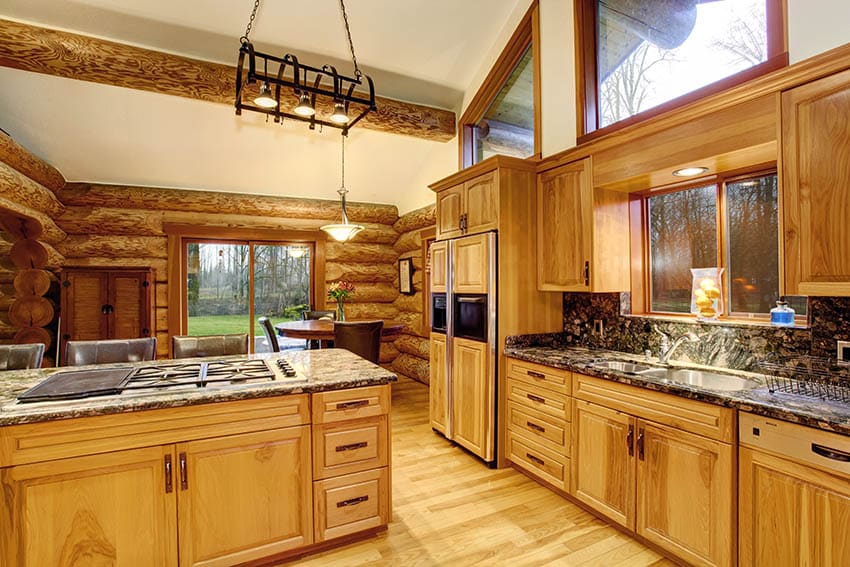
Hickory – Hickory has a similar graining pattern to oak, but its color is lighter. This type of wood is characterized by a natural creamy, pale yellow color. Although it can be stained, hickory is better treated with a clear stain or natural varnish in order to highlight its distinct blond tones. When it comes to strength, hickory is comparable to oak. It is a popular choice for rustic-inspired kitchens and is typically used for custom and semi-custom kitchen cabinets.
Birch – Birch is a type of fine-grained wood that has a slightly darker color than maple. It is also durable and can stand up to the wear and tear of everyday use. One of the most prized qualities of birch wood is that it finishes well. Offering versatility and flexibility in terms of application, birch wood may be stained or treated with faux finishes in order to achieve a more expensive look. Using the right type and color of wood stain, birch wood can also be easily passed off as cherry or maple. However, applying wood stain to birch requires extra care since it is prone to irregular coloring. Compared to other wood species, birch is less expensive.
Alder – Alder is a type of wood that has an even texture and a straight-grained pattern. It is characterized by a light brown color with slightly reddish undertones. Alder wood typically contains natural blemishes like pin holes, knots, cracks bird pecks, and mineral streaks. All together this forms a very unique, graceful pattern. The dramatic graining pattern of alder kitchen cabinets lends richness to kitchens. It is well suited for rustic-inspired settings.
Walnut – Walnut has a muted brown color and a smooth, even fine-grained pattern. Its surface is generally filled with straight grains that range from a light reddish gray brown color to a deep chocolate brown streaks. One of the most notable characteristics of walnut is that it ages gracefully, turning into a beautiful, mellow color over time. Walnut offers warmth to kitchen spaces, and they are highly suitable for a variety of design styles, whether it may be traditional, transitional, contemporary or modern.
Pre Made Cabinets
A great alternative to custom-made cabinets is ready-made kitchen cabinets. This is the perfect kitchen cabinet type for homeowners who want a simple and less expensive option. Ready-made kitchen cabinets are pre-made or assembled cabinets that are ready for installation. Compared to customized kitchen cabinetry, which is constructed on site, this type of storage undergoes the manufacturing, cutting, and assembly process in a factory or shop. It requires less time to install. There are several shops that specialize in this type of storage unit, and it is available in local home improvement stores, while some also offer it online.
Ready-to-assemble kitchen cabinets or RTA cabinets come in boxes containing all their components, hardware, and instructions for assembly. Ready-made kitchen cabinets are available as finished or unfinished.
Ready-made kitchen cabinets offer a great deal of convenience and savings in terms of cost. They are less expensive than semi-custom and custom kitchen cabinetry. However, one of its drawbacks is that it only has a limited number of styles and colors.
Modular Cabinets

One form of ready-made kitchen cabinets is modular kitchen systems. This type of kitchen cabinet is available in a broad spectrum of colors, styles, designs, and materials. The common materials used for ready-made kitchen cabinets are plywood and MDF or medium density fiberboard in high-pressure laminate finish. Some suppliers also offer glass-panelled cabinets.
Ordering ready-made kitchen systems and modular kitchens involves a systematic yet simple process. First, the manufacturer takes actual measurements of the existing kitchen space. Upon taking the measurements, they take the homeowner’s preference in styles, design, and space requirements. The manufacturers then proceed with creating proposals for the design and the kitchen layout based on the actual space measurements. Once approved, the kitchen cabinets are manufactured in a shop or production plant using the homeowner’s chosen material and finish. Once the production process is done, the kitchen cabinets are delivered and installed on-site. Typically, suppliers require a lead time for the design and the production process.
Modular kitchen cabinet suppliers have showrooms that display samples of their work and actual kitchen layout models. This allows the clients to get an idea of how their products look on an actual scale. In addition to that, ready-made suppliers also allow clients to browse over their material samples for the finishes and colors of the cabinet material and the countertops as well. With such, a client can get a full grasp of the feel, texture, and visuals of the cabinet materials.
Some modular cabinet suppliers also offer accessories to go along with their modular systems. These include wire baskets, utensil trays, trash bins, carousels, and pullouts. Ready-made cabinets also use a variety of mechanisms and hardware. The mechanisms range from hinges, pullouts, hydraulic hinges, etc. Hardware, cabinet handles, and knob, on the other hand, are offered in different finishes and styles, like brushed metal finish, satin finish, or chrome finish.
There are three primary options for cabinetry, namely: Semi-custom, custom, and stock cabinets. In summary, custom cabinets are made from scratch according to the specific requirements of the homeowner. Stock kitchen cabinets, on the other hand, are design-ready and bought as is. While semi-custom cabinets combine both types as it allows homeowners to modify and customize a given stock design.
Stock Cabinets
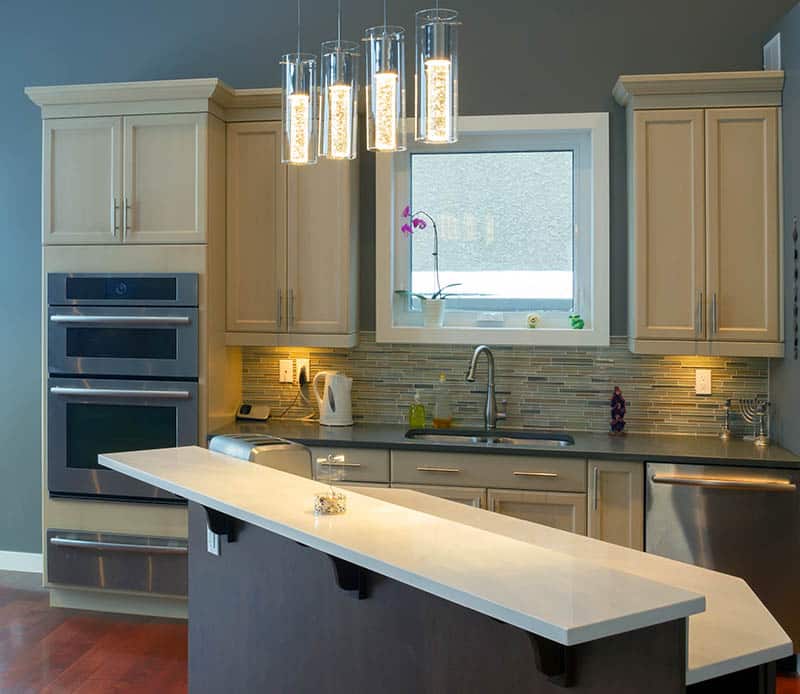
Among the three types of kitchen cabinet designs, stock kitchen cabinets are the least expensive. Primarily because they are bought on an “as is” basis, meaning they can not be modified, customized or changed. It is considered to be the simplest type of kitchen cabinetry.
Stock kitchen cabinets are sold in ready-made designs, which are pre-painted, pre-fabricated, and finished. It is available in a wide range of styles, colors, and finishes. However, compared to semi-custom and custom kitchen cabinets, their design is limited, and you do not get the full creative freedom to design your own kitchen cabinetry. With stock kitchen cabinets, you just have to be satisfied with what the supplier offers you. But despite this, stock kitchen cabinets offer the most affordable way to furnish a kitchen space.
Semi Custom Cabinets
Semi-custom kitchen cabinets are sold in basic or standard cabinet sizes, but unlike stock cabinets, clients and homeowners are allowed to modify the measurements of the cabinets, drawers, and doors. This also allows homeowners to incorporate their personal taste in their cabinetry. Just like stock kitchen cabinets, semi-custom cabinets are mass-produced. Semi-custom cabinets are available in a variety of design styles. Semi-custom kitchen cabinets may also be embellished with extra details like moldings, decorative ready-made carvings, and accents. Homeowners can choose which material to use, what cabinet door design to implement, and the type of color and finish that they prefer.
The primary advantage of semi-custom cabinets is that they allow homeowners to exercise creativity in customizing and modifying their cabinets without spending too much. Compared to custom kitchen cabinet options, they are less expensive. The modifications that are implemented in semi-custom cabinets include changes in door styles, color, accessories, and hardware. All of these allow flexibility in terms of design without the need for a long lead time. Additional details, however, cost extra and may take a longer time to produce. One effective way to control costs for semi-custom kitchen cabinets is to choose a standard-sized cabinet and customize it with a unique finish and hardware.
Custom Made Cabinets
Custom kitchen cabinets are built from scratch according to the specific design requirements and specifications of the homeowner. This type of kitchen cabinet is “made to order”. With custom kitchen cabinets, no components are rebuilt or pre-assembled. Everything is cut, crafted, and assembled by hand. These are typically built by skilled craftsmen, carpenters, and cabinet makers.
There are a number of advantages to custom kitchen cabinets. The primary benefit that it offers is that it gives flexibility and versatility in terms of design. Homeowners have the full freedom to choose and modify their kitchen cabinet’s color, material, finish, design, and style. Custom kitchen cabinets are tailor-made depending on the homeowner’s space requirements and needs. It can be made into any size, depth, length, and width, using any material or finish, embellished with any accessory. Custom kitchen cabinets can be made to fit into challenging spaces, no matter what the existing layout or set-up of your kitchen may be.
In addition to the creative freedom, custom kitchen cabinets can fit any design style, whether traditional or modern. And since you have the freedom to choose, you can ensure that the materials used for cabinets are highly durable, dependable and long-lasting. However, if you opt to choose custom kitchen cabinets for your home, make sure to consider the following factors. First is the lead time, as custom cabinets take longer time to produce and install. Next is that it requires an accurately measured plan of the existing kitchen space as the size of the custom cabinets will fully depend on it. Lastly, consider the budget, as custom cabinets come with a high price tag.
The high cost of custom cabinets is also considered to be its major drawback. In terms of cost, custom kitchen cabinets fall under the high-end range. Since every element of custom kitchen cabinets are made by hand from scratch, its labor costs for construction and installation take up a huge amount of the total project budget. Cabinet makers and craftsmen typically offer a steep price tag with their skilled expertise, and along with their exquisite craftsmanship, high-quality materials are employed to complete the work.
Cabinet Hardware
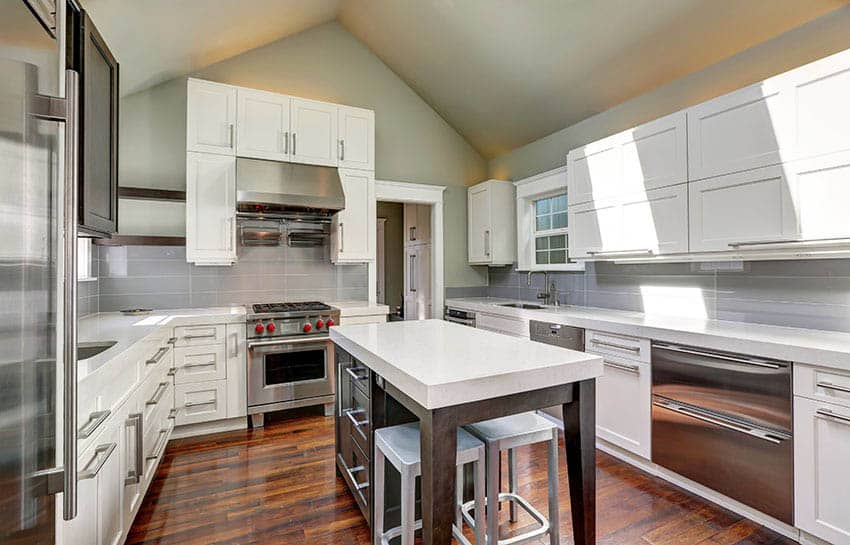
Kitchen cabinet knobs, pulls, and handles are features that are used to open and close cabinets. Aside from being utilitarian in nature, these handy elements are also used to increase the aesthetic appeal of your kitchen cabinetry. As decorative elements, kitchen cabinet hardware may be used as accents or as a complementing decor to the overall style of your cabinet.
There are an endless amount of options to choose from when it comes to kitchen cabinet hardware. It can either be made with metal, plastic, wood, or ceramic, while others even incorporate an interesting mix of this material to provide a more decorative look. Aside from the different materials, kitchen cabinet hardware is also available in several styles that can match any type of kitchen design. It is also available in different colors, finishes, and sizes.
Types of Kitchen Cabinet Hardware
Common kitchen cabinet hardware may be classified into three general groups, namely knobs, pulls or handles, and cup and bin pulls.

Cabinet knobs are generally round shaped but may also be square, rectangular, or diamond. Other popular shapes for cabinet knobs include the mushroom, oval, bar, crystal and novelty. Some common materials for cabinet knobs include metals like brass, zinc, die-cast, stainless steel, and bronze. In addition to these, suppliers also manufacture cabinet knobs in glass or crystal, stone, wood, ceramic, or plastic.
(See this kitchen cabinet knob at (Sponsored) Amazon)
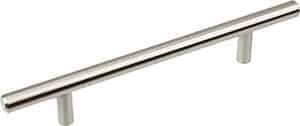
Similar to cabinet knobs, cabinet pulls and handles are typically made up of metal but may also use other materials like wood, plastic, or ceramic. Some of its common types are finger pulls, recessed handles, cup pulls, drop handles, pendant pulls, ring pulls, bar handles, bird cages, and appliances. (See this stainless steel bar pull at (Sponsored) Amazon)
When it comes to installation, cabinet pulls and handles make use of the “center to center” measurement, meaning the distance of the first screw to the second screw is taken from their centers. Cabinet pulls and handles may be mounted in the lower inner corner of the door or mounted in the center vertically. Although not commonly used for kitchen cabinets, cabinet handles may also be mounted at the center of the top or bottom portion of the door, horizontally. How you install it will greatly depend on your preference in style.

Compared to cabinet handles, cup pulls can only be opened from one direction. This is due to their unique shape and installation method, in which the bottom of the pull is open and the top is closed. Mounted with the open end facing downward, cup pulls are grabbed beneath and pulled to open a drawer. Their unique aesthetic provides a fresh look to traditional pulls. (See this satin nickel cup pull at (Sponsored) Amazon)
Types of cabinet hardware to use depending on style
Despite its size, cabinet pulls and handles contribute a big impact to the overall look of your kitchen cabinetry. When planning the design of your kitchen, details and accessories ae equally important. These hardware are often considered to be the “jewelry of the kitchen” because they can greatly enhance the look of your cabinets.
Aside from the profile, shape and style of the cabinet hardware, its color and finish are also design factors that one must consider when choosing the right cabinet hardware for your kitchen cabinets. The common finishes of cabinet hardware are brushed nickel finish, satin finish, chrome finish, antique pewter, light bronze or dark bronze, brass, oil-rubbed bronze, aluminum, matte black, rust, clear glass, wooden finish, or white. These finishes can serve as a guide for mixing and matching with your kitchen cabinets.
Choosing the right kitchen cabinet hardware is a matter of personal taste. There is no hard rule as to what you can use, but one effective approach is to choose based on the prevailing style of your kitchen. Keeping a strict style for the kitchen cabinets, components, accessories and features ensures a well-balanced and cohesive design.
Here are some of the most common cabinet hardware finishes, along with the cabinet styles that they are best paired with.
Polished Brass – Polished brass has a color that is similar to gold. It has a vibrant color that contributes brightness and livens up kitchens. This type of cabinet hardware finish stands out in any type of material and surface.
Styles it works with: Characterized by a sparkling look, polished brass cabinet hardware is the perfect match to country style and rustic inspired kitchens. It is best suited for both light and dark colored kitchen cabinets. Kitchen cabinetry with bright and deep colors is also ideal for this type of finish, as it creates an interesting contrast.
Antique Brass – Antique brass has a more aged look compared to polished brass. This is a durable type of cabinet hardware as it is made with strong materials like lead crystal and pewter. Compared to polished brass, antique brass has a more stylish appeal.
Styles it works with: Characterized by a classic look, antique brass cabinet hardware goes with a lot of kitchen design styles, but they are more commonly found in traditional and classic kitchen settings like country style. It is best suited for light-colored kitchen cabinets as they allow its color to stand out.
Black – Black is a popular color used for cabinet pulls and handles. It offers neutrality and versatility in terms of design matching. Black cabinet hardware can be used to create a bold statement in the kitchen without being too overpowering. Overall, black cabinet hardware has a stylish and elegant look.
Styles it works with: Characterized by a clean look, black cabinet hardware goes with a lot of kitchen design styles. It is popularly used for both traditional and contemporary settings.It is best suited for white or light-colored kitchen cabinets as they create contrast.
Antique finish – The old antique finish is characterized by a unique, deep brown color. This finish contributes a timeworn appeal and Old-World feel to kitchen cabinetry. The old antique finish can be matched with the crown moldings of kitchen cabinetry for a more unified look.
Styles it works with: Characterized by an aged yet timeless look, old antique cabinet hardware goes with traditional kitchen styles. It is the perfect match for light-colored kitchen cabinets.
Polished Chrome – Polished chrome is characterized by a bright silver color. Its bright appearance contributes shine to kitchens. This type of kitchen cabinet hardware finish is often complemented with matching appliances for a more uniform look.
Styles it works with: Characterized by sleek, modern yet conservative appeal, polished chrome cabinet hardware is more commonly used for modern and contemporary settings. It matches perfectly with both light and dark-colored cabinetry, even those with a painted finish.
Polished Nickel – Polished nickel is considered to be the “chameleon of cabinet hardware finishes”. Polished nickel has a more understated color compared to polished chrome and brass, but it has a glossy shine. This type of cabinet hardware finish can be used if you want your hardware to blend rather than stand out in an area. The main advantage of nickel cabinet hardware is its high durability. Nickel is one of the strongest metals, and in addition to that, it does not rust.
Styles it works with: Characterized by an elegant appeal, the polished nickel cabinet can have any design style. It looks exquisite in kitchens with highly decorative details because it’s a subdued look that does not compete with other finishes in the space. It works for any color of kitchen cabinets but pairs best with dark-colored cabinetry.
Silver Satin – Silver satin has a softer look compared to polished varieties. It does not have a shiny look but leans towards a more matte, brushed appearance. This type of hardware blends well with stainless steel appliances and is known for its durability and reliability. Fingerprints also do not mark easily on silver satin cabinet hardware.
Styles it works with: Characterized by a mellow color, silver satin cabinet hardware is typically used for utilitarian kitchens. This type of cabinet hardware finish is commonly paired with cherry-colored cabinets for contrast.
Antique Iron – Antique iron cabinet hardware is characterized by imperfections, which give it an extra interesting look. Aside from being sophisticated, this type of cabinet hardware is also sturdy. Its one-of-a-kind color and appearance produce different effects depending on the lighting conditions.
Styles it works with: Characterized by its rustic appeal, antique iron cabinet hardware is typically used for traditional kitchens which are country-inspired. It can also be used for contemporary settings if you want to fuse styles or add a bit of twist to your decor. This type of cabinet hardware finish can be paired with both light and dark cabinets.
Stainless Steel – Considered as one of the most practical materials and finishes for cabinet hardware, stainless steel is extremely durable and resilient. It has a sharp color, which offers a clean look.
Styles it works with: Characterized by its sharp aesthetics, stainless steel cabinet hardware is typically used for modern and contemporary kitchen settings. This type of cabinet hardware finish can be paired with both light and dark cabinets, but it stands out in dark and deep-colored kitchen cabinetry. It is also the perfect complement to the sleek, smooth surface of high gloss kitchen cabinets.
Nickel Chrome – Nickel chrome has a matte appearance, and its color is darker than polished nickel.
Styles it works with: Characterized by its muted color and sophisticated aesthetics, nickel chrome cabinet hardware are typically used for classic and rustic kitchen settings. This type of cabinet hardware finish works best with soft or light colored cabinetry because it creates contrast. Also, light backgrounds allow the natural color of nickel chrome hardware to stand out.
Cabinet Components
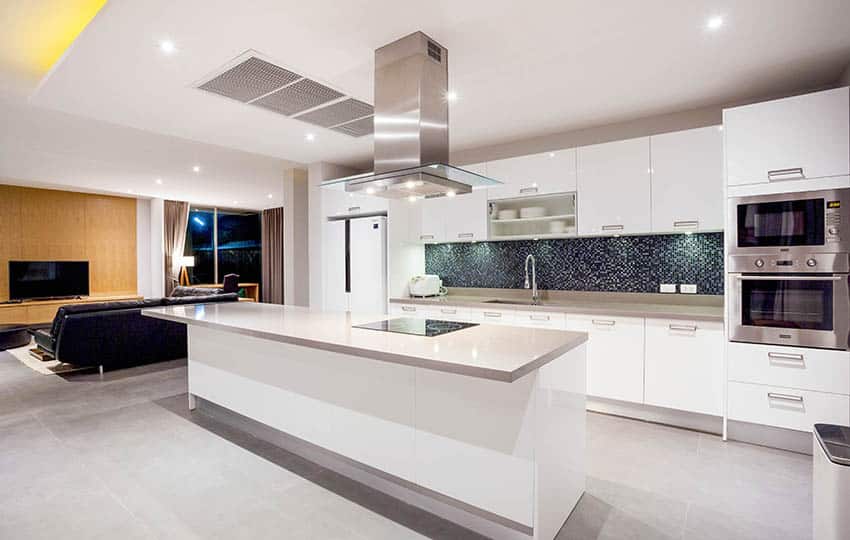
A kitchen cabinet is basically a type of box-like storage with a front door attached. But aside from the doors, there are several other components that make up a kitchen cabinet. It may be divided into two general parts: the cabinet front and the carcass or box. The front is made up of the face, frame, doors, and drawer fronts. The cabinet box or carcass, on the other hand, is made up of the side panels, back, top, bottom, drawer boxes, interior lining, and shelving.
The thickness of the cabinet components varies depending on the manufacturer and supplier. But typically, the materials used for such have thicknesses that range from ½ inches to ¾ inches. The quality components also relies on the type of materials employed in its construction. In addition to that, the manufacturing process, production, assembly method and installation also significantly affect the performance of the whole cabinetry.
Here are some of the kitchen cabinet components:
Cabinet Face Frame – The cabinet face frame pertains to the whole front or face of the cabinet. This component can only be seen in the “framed kitchen cabinet style”. The main purpose of the cabinet face frame is to hold the door in place. The materials used for this component are typically hardwood, and its thickness ranges from ¾ inches to 1 ½ inches. The face frame is made up of two general parts: the stiles and the rails. The stiles are the vertical pieces that make up the frame, while the rails are the horizontal members. These parts can be joined by screws, but in high-quality construction methods, dowels are used.
Cabinet Doors and Drawer Fronts – Cabinet doors are the components that you use to close and open the units, while the drawer fronts pertain to the faces of the drawers. Just like the frame, these components are also made up of solid wood and must have a thickness of at least ¾ inches.Doors and drawer fronts are also made up of rails and stiles that have a thickness of ½ inches to 3 inches. These rails and stiles make up the door frame which holds the center panel in place. The door center panel material and design vary depending on the overall style of the unit.
Doors are available in different styles and designs. As mentioned in this article, some examples of these are the recessed panel and raised panel door style. When we speak of the term “cabinet doors”, we often use inset panel style, cathedral door style, double arch or single arch, mullion and accent, shaker style, and flat panel. Although hardwood is the most common material for cabinet doors, some other options for these components are MDF or medium density fiberboard or plywood covered in veneer or laminates.
Drawer Boxes – Drawer boxes are box-shaped storage units that fit into the frame. They are usually fixed with rollers and glides and operate with a simple push-and-pull sliding motion. According to American standards for quality, boxes must be made up of solid hardwood and must be at least ½ inches thick. The bottom part of the drawer box must be made up of plywood and must be sturdily attached to the sides, front, and back of the drawer box. Traditional construction methods and professional craftsmanship typically make use of dovetail joints to create the drawer box.
Less expensive drawer boxes make use of other materials like particle board, metal, plastic, or plywood for the sides. And instead of using dovetail joints, which firmly set them together, butt or rabbet joints are used.
Drawer boxes have to be very durable and must have a sturdy build. The simple utensil drawer is opened at least six times a day, which means it is one of the most used parts of the cabinetry. In addition to that, it also carries a lot of weight, so make sure that the material and construction method you use for this cabinet component perform well.
Interior Finish Material – Materials for the interior parts of the cabinets as well as the inner shelves must be able to withstand the wear and tear of everyday use, be easy to clean, and non-porous. Standard interior finishes for cabinets are melamine and melamine laminates, which are types of polymer that are applied to plywood or particle boards.
When choosing the right material for your cabinet’s interior finish, opt for those that can last long without staining, cracking, or bubbling. Light colors are also preferable since they allow the users to see the contents of the cabinets more easily. Wood veneers are also not recommended for use as interior finishing for cabinets as they tend to absorb moisture faster and show wear more easily. It does not stand up well to strong cleaning solutions and may become damaged by excessive humidity and moisture from dishwashing.
Shelves – The primary consideration for cabinet interior shelves is strength. These interior or inner shelves hold up a lot of weight from storing stacks of dinnerware, pots and pans or glassware. With such, they must be able to stand up to the weight and wear and tear of daily use. The minimum thickness for cabinet shelving is ½ inches, but ¾ inches is more preferred. The depth of the cabinet shelving may either be full or half, but the former is more advisable since it allows you to maximize your cabinet storage capacity.
Common materials used for cabinet shelves include plywood and particle boards. Among the two, plywood is stronger and less likely to sag than particle boards. Particle boards are less expensive but have the tendency to bend under heavy weight and may warp or expand when exposed to moisture.
Cabinet Features
Aside from the cabinet components and parts, there are still other elements that makeup kitchen cabinetry. These cabinet features are used to aid in efficiency accessibility and provide a better performing kitchen cabinetry system.
Here are some added cabinet features:
Cabinet hardware – In addition to drawers, knobs, and pulls, cabinet hardware also includes mechanisms that are used to operate kitchen cabinetry. These include kitchen cabinet hinges, pull-outs, glides and rollers, etc. There are several manufacturers that offer a soft close technology for cabinet hardware which allows for more convenience and ease of use.
Hinges are used to hold the cabinet door and frame together, and at the same time, it is the mechanism that allows you to open and close cabinets. The type of hinges used for cabinetry depends on the style of the door and the type of cabinet. It can either be exposed or concealed.
Concealed hinges are hinges that are hidden and cannot be seen when the cabinet doors are closed. Exposed hinges are hinges that are fully visible from the outside of the cabinet. Concealed hinges are typically used for full overlay doors. Hinges must always be high quality as their doors are constantly open and closed multiple times.
Drawer Glides, Slides, and Runners are used to provide drawers an easy “in and out” movement from their boxes. Just like the hinges, these mechanisms must be highly durable since they are subjected to heavy daily use. In general, glides must be made up of high-quality steel ball bearings and have a buffer closing system. These are usually concealed and must be able to support at least 90 pounds of weight while being able to glide, open and close smoothly. Another primary requirement for drawer glides is that they must be able to extend fully and provide complete access in order to allow the user to see all of the contents of the drawers.
Drawer glides may be classified into two categories, namely drawer slides and runners. Drawer slides are hardwares which are fixed to the side of the unit and the carcass or box. To aid in the “in and out” movement of the drawers, ball bearings are used, giving a noiseless and smooth operation. Slides are considered to be heavy duty and can support heavy loads. They are better compared to drawer runners.
Drawer runners are fixed to the bottom edge of the unit and the carcass or box. Just like slides, runners also make use of ball bearings to facilitate the in-and-out action. However, the difference is that the size of these bearings is smaller, thus providing a smoother movement. This type of mechanism is recommended for light-bearing drawers.
Accessories – Kitchen cabinet accessories are significant in terms of achieving the optimum capacity of your storage, providing ease of use, increasing accessibility, and keeping things organized. These include wire baskets, utensil trays and dividers, plate racks, lazy Susan, pantry pullouts, spice rack organizers, and trash bins, to name a few. Not only are these accessories functional, but they also contribute to the aesthetics of your cabinetry interiors. Of course, seeing your plates, utensils, and other kitchen tools in their respective places is satisfying. Wine racks and plate displays may also be used as focal points in the kitchen.
Some other examples of cabinet accessories are:
• Spice racks – Storing your ingredients in a spice rack or spice drawer keeps everything within reach and improves the efficiency of workflow in the kitchen.
• Cutlery and utensil trays – for organizing silverware like spoons, forks and knives
• Recycling bins – that slide out, allowing you to conceal your trash
• Lazy susans – which allow you to make use of corners and dead spaces while accessing everything you need with a simple turning motion
• Appliance racks – for small appliances like toasters, blenders, mixers and coffee makers, which provide easy set up when needed and give a fast way to stow away appliances when not in use
• Pull-out tables – can be used as an extended working space or preparation counter and can be put back when not in use
• Roll out drawer trays – for storing other kitchen tools and essentials while keeping things organized
• Pantry pullouts – for storing dry ingredients, at the same time maximizes storage space
• Swing out storages – provides easier access to kitchen essentials without having the need to reach the full depth of the cabinet
Lighting – Under-cabinet, above-cabinet, and interior lighting may be added to cabinets to provide added illumination and task lighting to your kitchen space. Localized lighting allows you to perform your task better while at the same time giving added aesthetics and brightening the space.
There are a variety of lighting options to choose from, and these can be added as long as you have an electrical provision for them. Strip lights are an effective way to add above-cabinet lighting as they are not expensive yet provide an adequate amount of illumination. Task lighting may also be used under the cabinets if you want increased brightness during food prep work. Interior cabinet lights are added inside the cabinets themselves if you want to get a better view of the contents.
Decorative lighting, on the other hand, provides improved ambiance and creates a more cozy and inviting atmosphere for your kitchen. Some suppliers also offer automatic lights, which instantly turn on once the cabinets are reopened. Alternatively, sensor lights may also be used if you want a no-touch technology.
Design Ideas for Cabinets in the Kitchen
Below, we share a variety of ideas showcasing the different cabinetry styles available.
Contemporary Cabinets

The word contemporary pertains to the current or present, and the same thing goes in terms of design. The contemporary style pertains to what is currently in trend. This style takes after the modern style; thus, they basically have the same attributes. (Visit this page to see our contemporary kitchen cabinets gallery)
Characterized by a sleek look and minimalist aesthetics, contemporary style cabinets generally have simple surfaces which have little to no ornamentation. Unlike traditional styles, it does not have any decorative moldings or carvings, favors clean lines, and makes use of flat surfaces rather than raised panels. Its hardware is also sleek and non-embellished.
Contemporary style units generally have a crisp look. And their clean aesthetics often make kitchen spaces appear more spacious and bright. This style is also typically made up of modern materials like metal, glass, or plastic. However, wood or wood veneer is also used to soften its look. Popular colors for contemporary style units include neutrals and typically have a monochromatic palette. Colors like white, black, and gray are used to achieve a sharp look. Bright and bold colors are also typically used as accents.
Modern Cabinets
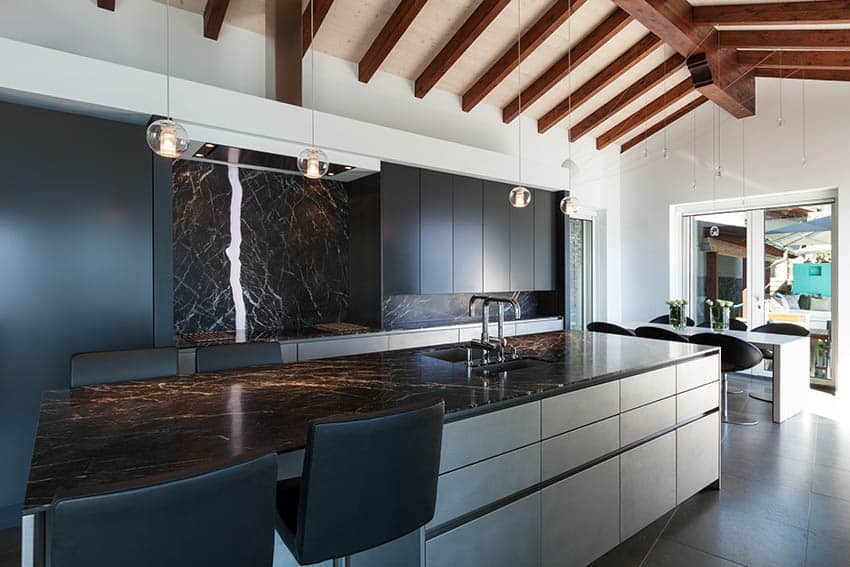
Modern kitchen cabinet styles are characterized by angular lines, geometric forms, smooth surfaces, and minimal orientation. In general, this style is simple and has a sleek, streamlined look. (Visit this page to see our modern kitchen cabinets gallery) Although geared towards more angular lines, modern styles also use curved forms and angles. It also features flat surfaces with little to no details of carvings, moldings, or panels. It just simple, plain, and sleek.
Similar to contemporary designs, the modern style typically makes use of man-made and synthetic materials like plastic, metal, glass, and concrete or, in some cases, mixed materials. Modern cabinets are also usually finished with laminates, wood veneers, or frosted glass panels. Wood is also used in this style, but instead of using one type of finish, this storage style combines different finishes. Prominent horizontal graining patterns are also prevalent in this style. Natural wood and bold colors are part of the palette. Bold accents like deep reds, oranges, green, and blue are also added to give a splash of color.
Traditional Cabinets
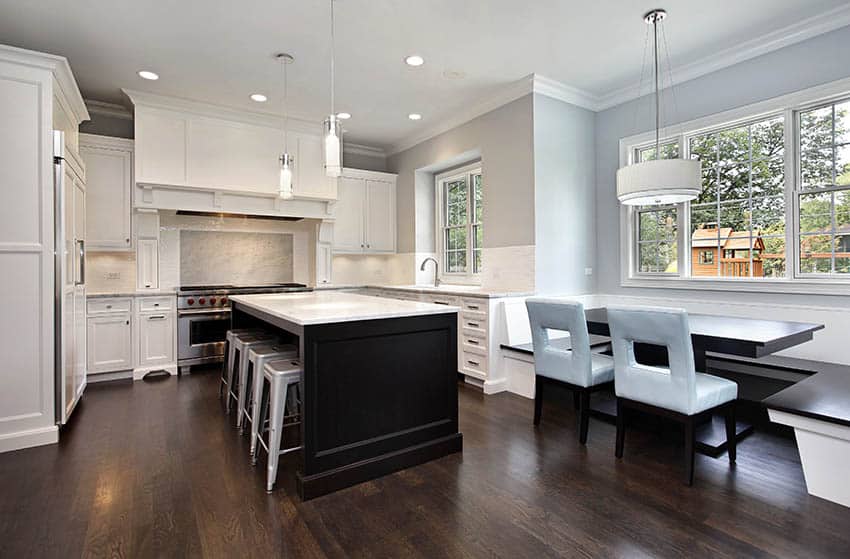
Traditional kitchen cabinet design encompasses a number of styles that have a historical origin. This became popular during the 18th to 21st century, with influences of the American and European styles. (Visit this page to see our traditional kitchen cabinets gallery.) Traditional designs are characterized by natural materials and rich woods in natural finishes. Aside from allowing the natural color of wood to stand out, muted tones are also commonly used for this style. White is also another popular color and is favored in this style for its classic, timeless appeal. (Check out our gallery of kitchens with white cabinets for more ideas.) When it comes to the cabinetry faces, door, and components, traditional options often feature decorative details like crown moldings, paneling, and intricate carvings.
Country Cabinets
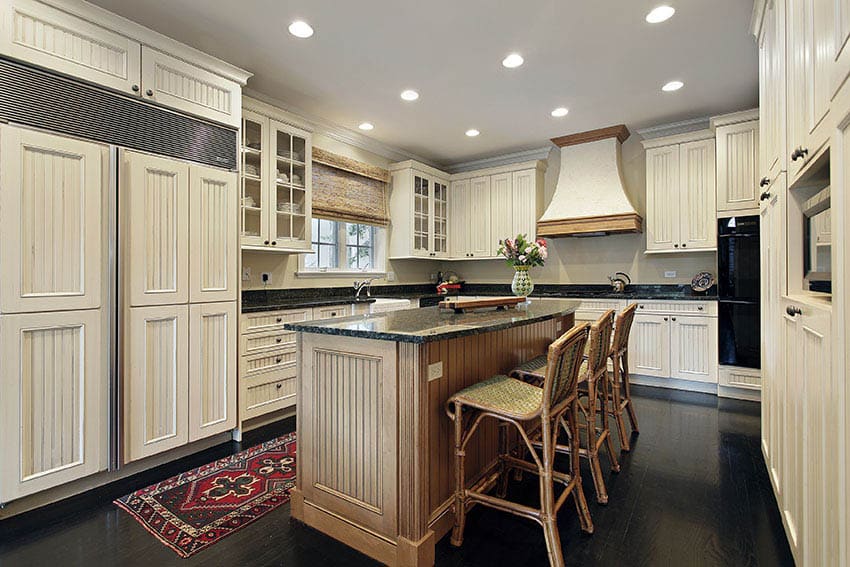
Country kitchen cabinets fall under the traditional kitchen cabinet style and is characterized by a timeless appearance and a charming feel. This type of kitchen cabinetry gives off a warm and inviting atmosphere. (See pictures of more types of country kitchen cabinets on this page) Materials for country designs are usually durable, sturdy, and long-lasting, so they typically use solid wood as the primary material. Pines, cherry, oak, maple, and hickory are some of the popular wood species to consider.
The design of country cabinetry makes use of decorative moldings and charming features. Raised panel doors and beadboards are featured to add to that homelike vibe. Other door face options for country cabinets are stained glass and wire. The signature look of country-style optiosn includes natural wood in stain or painted finish. The natural color of wood is allowed to take center stage in this style. Alternatively, white, off-white, creamy beige, and distressed finishes are also commonly used. Glazing is also another option for the finishing as it gives an Old World feel. For those who want a bit of color, soft and mellow colors such as pale blue, mint green, buttery yellow and other pastels may also be explored for painting.
Rustic Cabinets
The Rustic kitchen style is associated with anything timeworn, natural, warm, and casual. Rustic style and country are alike and fall under the traditional style. This type has an inviting feel and projects natural coziness. (Visit this page to see our rustic kitchen cabinets gallery) Natural materials are one of the signature features of the rustic style. Just like country style kitchens, wood is predominantly used as the primary material for cabinetry. Common species of wood include pine, oak, maple, cherry, and hickory. However, with rustic style cabinetry it is often left unfinished in order to showcase its natural color. Instead of glossy stains, rustic cabinets may also be left rugged in order to enhance their undertones and highlight the pureness and authenticity of the wood. Colors used for rustic style cabinets are typically warm, deep, and natural , ranging from earth tones and browns.
Craftsman Cabinets
Craftsman style kitchens are always directly associated with stunning cabinetry. Classified under the traditional style, the craftsman style originated during the 19th century as a result of the popular Arts and Crafts Movement. (Take a look at our gallery of craftsman kitchen cabinets on this page). Craftsman style cabinetry is known for their utilitarian nature. This type is geared towards functionality rather than ornamentation. It gives more emphasis on craftsmanship and puts a premium on simplicity. Although utilitarian in nature, the craftsman style still became one of the most visually captivating and stand-out design styles in history. It is the perfect marriage of form and function.
Overall, craftsman style cabinets are defined by three basic principles: a straightforward design with clean lines, high-quality construction, and minimal ornamentation. To achieve such, specific design features are employed. First, door fronts have clean lines, a no-fuss design, and authentic details. It is generally straightforward and favors function more rather than a heavy ornate cabinet design that has heavily carved details and ornamentation. Craftsman style options typically have square, straight edges with either flat panel doors, raised panel doors or simple framed glass doors. In some cases, leaded glass doors are also used.
Second, instead of featuring embellishments, craftsman style cabinets showcase quality joinery. Some joinery that are featured in this type of storage space are dovetail joints, mortise and tenon joints, miter joints and butt joints. Dowels can also be used instead of nails. Lastly, they make use of solid wood in rich colors. The main material that is predominantly used for this type of design is solid wood. Instead of using artificial materials, a true craftsman style makes use of heavy woods such as oak, cherry, maple, pine, and hickory. Quarter-sawn oak is a traditional favorite among the five wood species. Quarter sawn The wood is also usually finished in a deep-colored stain in order to enhance its rich undertones and fine-graining patterns. It can also be left unpainted and true to its natural state, allowing the inherent graining pattern and distinct aesthetics to stand out in the space.
Tuscan Cabinets
The Tuscan style originated in the countryside of Italy. This type of design puts emphasis on culinary traditions, projecting warmth, welcome, and a cozy, homelike vibe. It explores the joys of cooking and eating. In general, the Tuscan-style evokes a Mediterranean feel. The primary materials used for Tuscan-inspired units are high-quality hardwoods like maple and cherry. To project a sense of warmth, deep, rich brown stains are used as its finishing material. Metals like bronze, copper, brass and iron are also typically used as a complement to the rich natural wood. Backsplashes are often accentuated with handpainted Italian tiles which have warm accents such as shades of brown and mustard. Deep greens and dark reds are also commonly used to add a splash of color that brightens up the space. These vivid accents are also sometimes used as a cabinet color to evoke more life and warmth in a Tuscan design.
The design for Tuscan cabinets features raised panel doors with decorative accents like moldings, cornices, and shelves. Alternatively, glass paneled doors are also used to convey a more elegant design. Other types for Tuscan kitchen designs feature display racks for dinnerware, cookware, and spices. Pots and pans are also typically showcased and hung on wrought iron racks. Overall, the main goal of this type is to create a warm, appealing, lively vibe.
Farmhouse Cabinets
The farmhouse style evokes country comfort, natural coziness, and a warm, welcoming atmosphere. It is also often associated with the word “rustic” because of its raw, natural appeal and charm. Generally, farmhouse style kitchens are geared towards a “down home” theme. (See our gallery of farmhouse kitchen cabinets here) Natural materials are one of the primary elements of the Farmhouse style. With that in mind, Farmhouse cupboards and drawers are dominantly made up of quality hardwood like maple, cherry, oak and pine. Pine is a popular choice for farmhouse cabinets because its knotty appearance exudes a rustic vibe.
Paint is used as the primary finish for farmhouse style cabinets. White paint is the most common color for farmhouse style cabinets, but soft, muted shades like cool grays, soft blues, beige and light taupe can also be used. Door faces are often accentuated with heavy molding and cornices. Beadboard panel doors are also popular features for farmhouse styles, because of their classic charm. Alternatively, glass paneled doors and open shelving are also widely used to feature dainty dinnerware, glassware or mason jars. Farmhouse style cupboards are also often combined with other rustic elements like a deep, wide, oversized porcelain or stainless steel sink. Vintage accents and old-fashioned accessories are also displayed in the cabinets to create a more “lived-in” feel.
European Style Cupboards
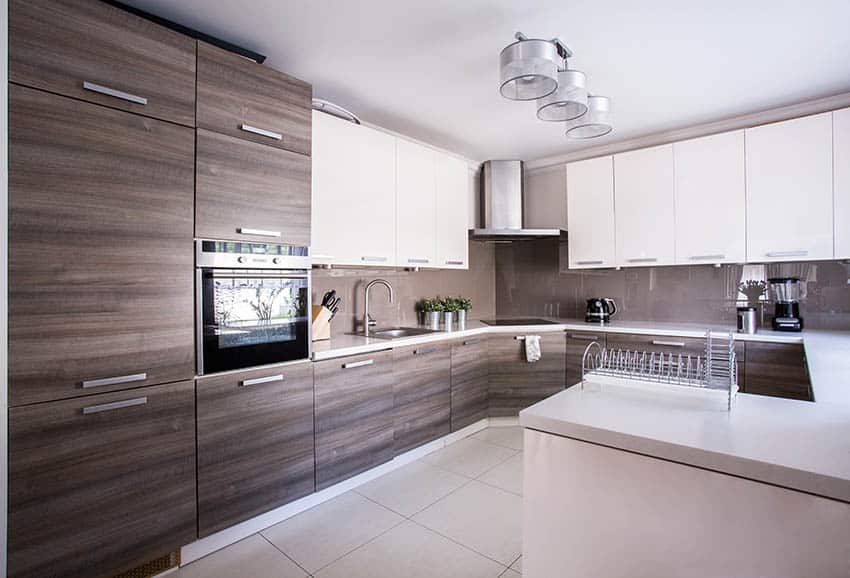
European style cabinets are generally characterized by an industrial and functional appeal. This type is adapted inspiration from the American style but have a more sleek look. The simplicity and straightforward design of European style options make them perfectly suited for contemporary and modern kitchen settings. (See our gallery of European kitchen cabinets here) The trademark look of European style cabinets is that they are frameless. And since they do not have frames, the cabinetry bends seamlessly with each other. This option also does not feature any horizontal rails or vertical stiles. European style units also feature simple metal hardware that has a sleek appearance and streamlined design.
European style cabinets also aim to focus on efficiency and functionality. Since European flats are smaller, the design’s main goal was to create a compact size cabinetry that is fully functional and maximizes space. The frameless design offers an added benefit in terms of accessibility and ease of use.
The materials used for European-style cabinets vary, ranging from natural materials like wood to more modern alternatives like MDF and particle board. When it comes to finishes, the most frequently used materials are laminates. Laminates are typically attached to a substrate material to reinforce strength and durability. Laminates provide for more color options and also come in designs that mimic the appearance of real wood. It is also widely available in bold colors which can work well in striking European style kitchens.
Cottage Style Inspired Cupboards
Cottage style kitchens are generally known for their charm, classic flair and timeless appeal. Although traditional, the cottage style evokes a less formal atmosphere. It is also considered to be eclectic since it fuses the traditional and the new by taming down formal design elements with modern accents. The signature look of cottage style cabinetry revolves around antique details, but nowadays, designers tend to blend old and new to create a more casual vibe and a fresher look. Antique details such as crown moldings, cornices and weathered hardware are common features. Another important facet of the cottage-style is an open design. They often lack doors to provide more accessibility and for displaying charming dinnerware.
The traditional choice of material for cottage style cabinets is wood. Some popular species include maple, cherry, and hickory. Paint in white or creamy tones is also widely used as a finishing material for cottage style kitchens. Other neutrals such as gray and tans are also perfect complements to this cabinet style. Soft hues and pastels also add a touch of charm to cottage style cabinets. For a more eclectic vibe, contrasting colors for the cabinets and the center island may also be explored. Cottage style units are usually paired with luxurious finishes like a white marble countertop and porcelain tile splashboard.
Mexican Style Drawers
The Mexican kitchen style reminds us of anything warm, lively and inviting. In simpler terms, it offers more “spice” and a bolder, cheery atmosphere. It is also generally characterized by a rough, rustic feel. Mexican style cabinets have raised panel cabinetry with simple millwork. Rather than focusing on details, this cabinet style gives more emphasis on creating a rustic, warm-toned toned and bold colored design. The design of Mexican style cabinetry also often feature open faced units which display colorful handcrafted dinnerware.
The Mexican culture and heritage remind us of a vibrant character and this is often reflected in a kitchen design through the use of lively colors. The Mexican cabinet style is a bolder choice in terms of finishes. It favors contrast more rather than blending. Wooden cupboards are typically given a distressed look using faux finishing techniques. Vibrant colors such as scarlet reds, bright greens and turquoise are also popularly used for the cabinet frames and even the handles.
The door hardware used for Mexican style cabinets has subtle touches of Mexican inspiration. Geometric details and leaf motifs may either be carved or embossed into metal cabinet pull and handles or, in some cases, hand-painted over ceramic cabinet hardware. Mexican style options are typically complemented with colorful handcrafted tiles with painted surfaces. Mexican inspired motifs with bold and bright colors of blue, greens, yellow, and reds. Some other design elements that can be used to match the Mexican style are white crackled trims, black granite countertops and honey golden accents. Mexican style cabinets may also be set against a warm colored wall to evoke a bright, cheery ambiance in a room. Terra cotta floors and natural stone flooring are also common options for complementing decor to a Mexican style.
Retro Inspired Cabinets
The retro style is a mix of decades of old styles and it is influenced by the trends in the past. In essence, retro style kitchens are like “throwbacks” which generally evoke a nostalgic feel. It sometimes reminds us of a “diner-like” ambiance. Retro inspired cabinets are the perfect marriage of classic flair and contemporary vibe. It also puts emphasis on a sturdy build and functionality. The most popular design for retro inspiration is mid-century modern. This style is characterized by a sleek appearance, streamline design, angular lines and geometric forms. The design is more seamless, plain, and simple. And just like the modern style, it does not make use of ornamentation such as decorative details, moldings, cornices or carvings. Materials may either be solid wood, laminate or veneers. Colors and finishes for mid-century retro drawers include light to medium-stained woods.
Post war style or the 1950’s American style is also another inspiration for retro inspired kitchens. This style generally evokes a futuristic, space age vibe. Translated into cabinet designs, this features prominent curves and sharp angles. Finishes for post-war retro cupboards are more bold in color. Bright reds, blues, and greens in high gloss finish are also prevalent. This cabinet style is also typically accentuated with shiny, oversized chrome handles. Retro-inspired cabinets are typically complemented with retro furniture pieces, appliances, and artworks to project a more vintage feel. Replicas and memorabilia are also commonly showcased as part of the design.
Cabinets in French Style
The French country style is one of the most ornate designs for kitchens. It falls under the traditional style, evoking a strong sense of elegance, sophistication, richness, and luxury. In general, French country cabinetry are characterized by distressed finishes, rich woods, and warm colors. The design for French country style kitchens typically includes ornate details such as intricate wood carvings, decorative moldings, and cornices. Cabinet faces also commonly have arches, raised panels, and decorative edges. The beadboard door design is also commonly used in French country cabinet design to achieve a more casual feel. Mixed metals such as copper and bronze may also be incorporated into the design to add a more ornate aesthetic appeal. Alternatively, grille doors and leaded glass can also be used as complementing elements to rich wooden cabinetry.
Natural materials such as wood are the primary materials for French style cabinetry. To create a rustic character, these woods are often left in their natural, unfinished state, showcasing their distinct graining patterns. In some cases, the distressed, antique, or weathered finish is also employed to create a more time-worn Old World vibe. Rich, warm tones and deep colors are also more popularly used compared to light colors. If the cabinets are painted, they are typically finished in earth tones and cream or beige. Complementing color schemes for French country storage units include warm tones like shades of brown, deep reds, and mustard. Wooden French country cabinetry is also complemented with other rich finishes and materials. Door hardware is typically made up of metals like iron, brass, and bronze in an antique finish.
Cabinets in Mission Style
The Mission style originated in the United States during the 20th century. This style started with furniture design but was later on adapted into cabinetry design. The Mission style is also the primary inspiration for the Arts and Crafts Movement style or the Craftsman style, but it particularly combines influences that are Spanish in origin.
Similar to the straightforward design of the Craftsman style, Mission style cabinetry is characterized by simple, straight lines with little to ornamentation. Paneled doors are also favored over designs with heavy carvings and details. This type of cabinet style is made by skilled craftsmen, thus ensuring a sturdy build and long-lasting design.
Natural solid wood is the primary material for Mission style cupboards. Oak or American white oak is the most popular species used. Cherry is another durable option and looks exquisite in Mission style design because their rich natural color is showcased more. This type of cabinet design is also often left in its natural, unfinished state. They are never treated with an opaque paint but can be stained to enhance the richness of their undertones. Warm colors and deep hues are popular wood stain colors for the Mission style cabinet.
When it comes to the hardware, Mission style cabinetry makes use of utilitarian and functional designs. These are typically made up of black wrought iron, bronze, and rubbed brass. Mission style units also a custom-made option and may cost more compared to other cabinet design styles. It is also expensive because of the use of high-quality materials and the employment of skilled professionals during production. To stay true to Mission style aesthetics, these cabinets are complemented with decors such as stained glass lighting fixtures. Mission style cabinetry is also incorporated with built-in storage benches or breakfast nooks.
Cabinets in Transitional Style
Transitional kitchen features a fusion of traditional and contemporary design styles to create a well-balanced look for your home. It combines the simplicity of contemporary design and the warmth of traditional design. By incorporating details from the past with contemporary decor, a more fresh and updated setting is created.
This design leans towards a more modern look. Characterized by defined lines, a streamlined profile, and simple paneled doors. Its design is simple yet allows minimal use of ornamentation like millwork, cornices, and corbels. However, these design details are kept subdued instead of being highly intricate and elaborate. The more fancy the decor is, the more traditional it becomes, so make sure to choose cabinet details that are neutral and mellow.
Instead of using synthetic materials, transitional these make use of wood in a painted finish. Neutral colors such as white, beige, brown, and soft pastel shades are popular cabinet colors. Two tone kitchen cabinets paired with a primary color and white as an accent can be a great way to incorporate visual interest and balance.
Transitional style cupboards are typically complemented with minimal accents, a classic backsplash in a uniform pattern, and natural stone countertops. This type of cabinet material is also incorporated into a monochromatic palette.

